Rock Fashion History from 1950s to Current Days
Rock, a musical genre that emerged in the 1950s with roots in jazz and blues, has been a paramount part of fashion with its dynamic styles and ways of dressing.
Over the last seven decades, the Rock movement has been a dominant cultural force, creating societal, cultural, and fashion changes.

For example, 1950s Rock music fans adopted leather jackets and denim jeans to showcase a blend of youthful energy and rebellious nature.
In the 1970s, glam rockers adopted theatrical costumes while the punk movement resorted to torn clothing and anti-establishment logos.
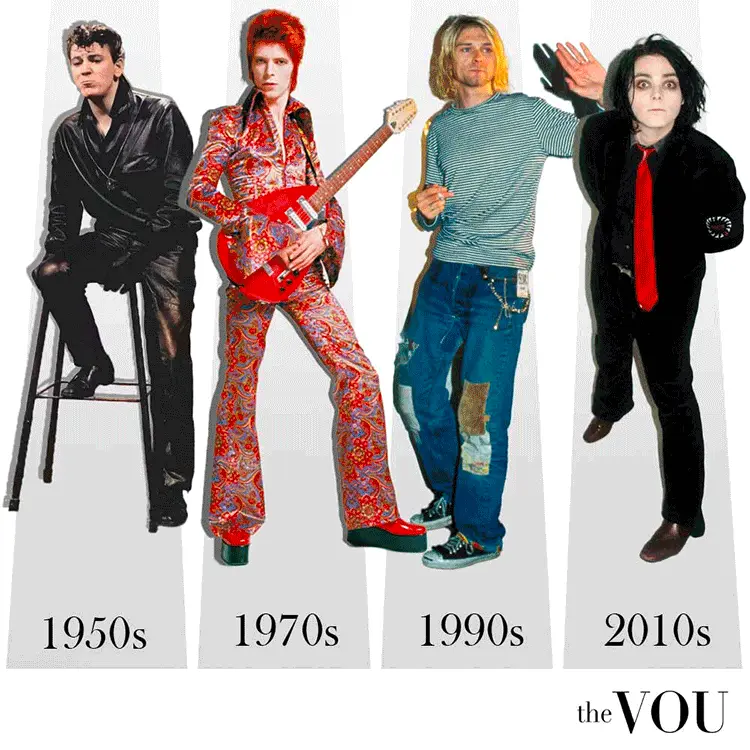
Each era’s Rock music, attitudes, and ideologies are intertwined with fashion styles, mirroring the genre’s evolution and the societal context.
In this article, we’ll uncover the history of Rock fashion, the symbolism behind iconic clothing, and how the Rock movement impacts current fashion trends.
It is time to explore the parallel evolution of music and fashion over the decades and the advent of several rock fashion style variations.
1950s – The Origin of Rock Fashion
Influenced by the emergence of rock ‘n’ roll, the 1950s marked a significant era in fashion history.
This period saw a dramatic shift from the auster and conservative looks of the post-war era to more expressive and rebellious outfits, reflecting the cultural and societal changes of the time.
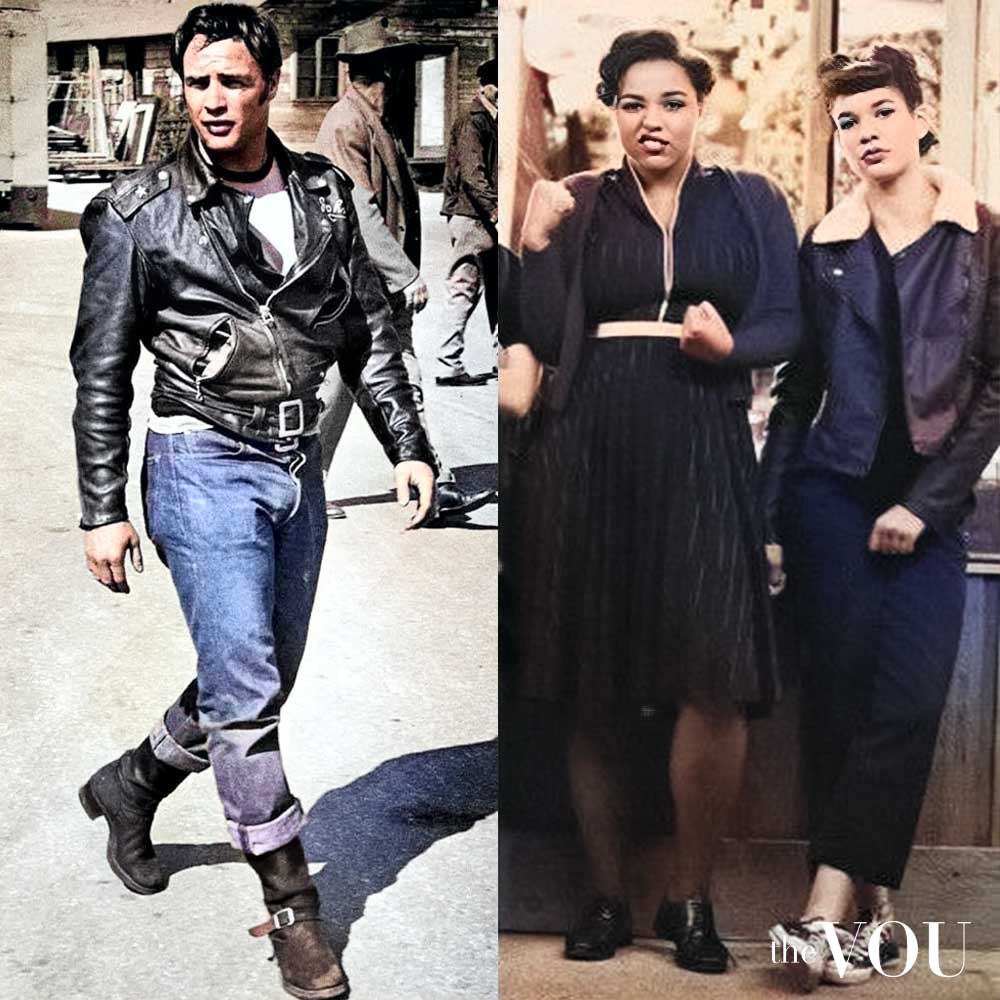
The onset of rock ‘n’ roll, a unique blend of blues, country, R&B, and gospel, resonated with the younger generation’s desire for freedom and self-expression, giving birth to Rockabilly fashion.
Rockabilly Fashion
Tied to the rock and roll and country-western music scenes, the impact of Rockabilly extended beyond music and into clothing.
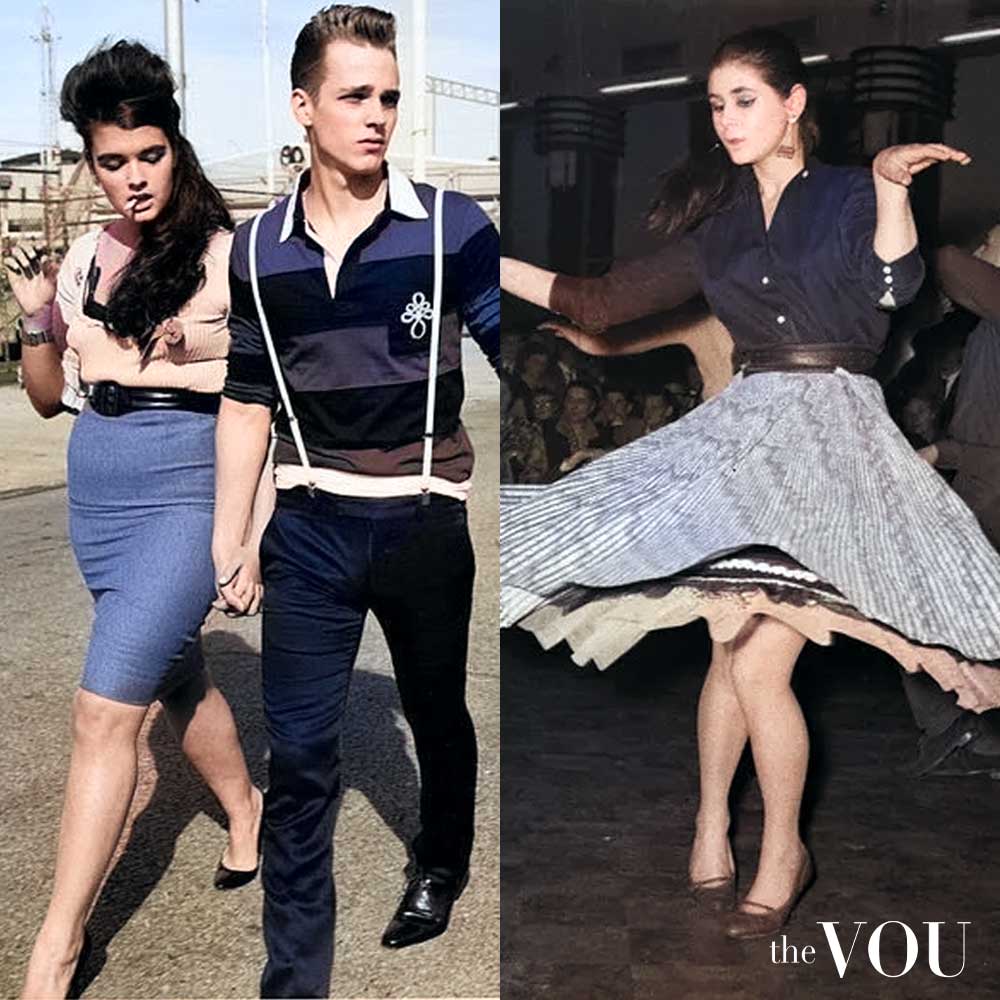
Music icons like Elvis Presley, Jerry Lee Lewis, and Johnny Cash became synonymous with rockabilly fashion and a style associated with anti-racism and anti-conformity movements.
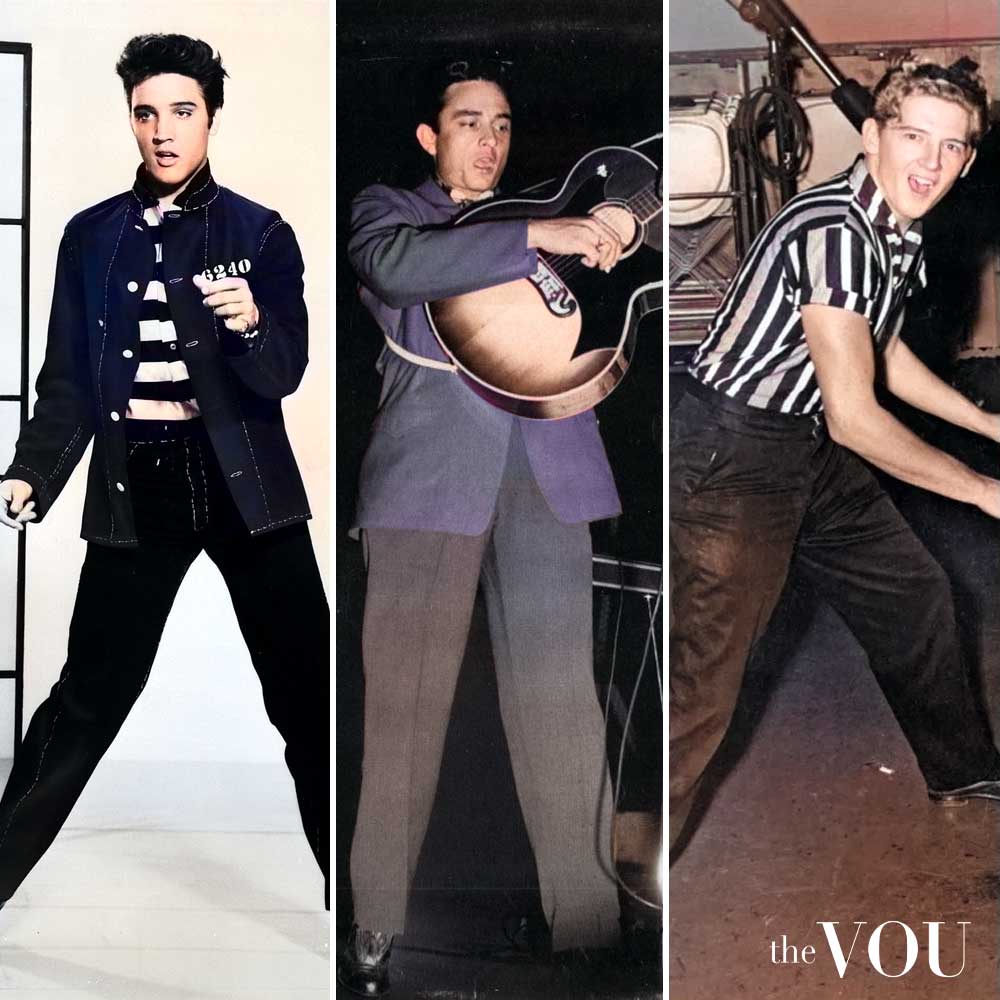
With distinctive outfits, icons like Wanda Jackson, Brenda Lee, Janis Martin, June Carter, and Lorrie Collins inspired a generation of women to embrace the rockabilly aesthetic.
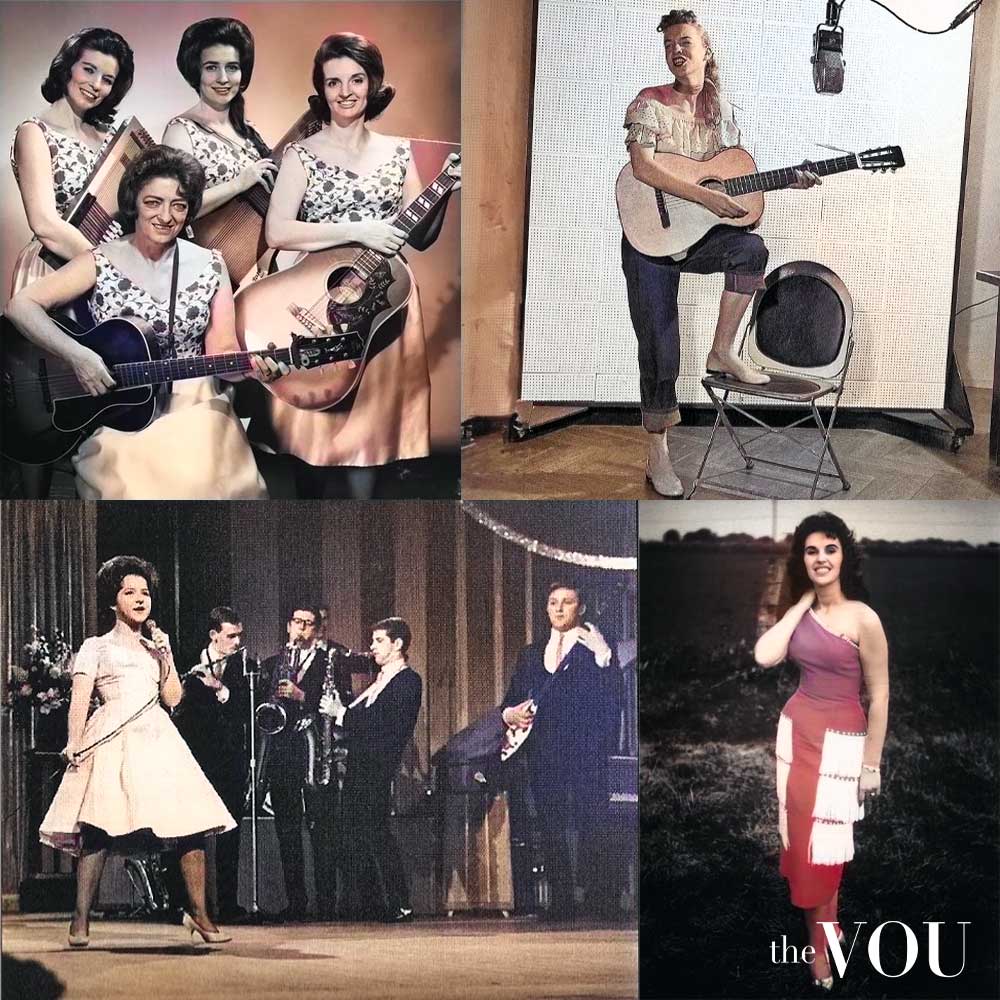
Women’s fashion was characterized by form-fitting dresses with full skirts, halter tops, high-waisted pants, and hairstyles with victory rolls, pin curls, and beehives, emphasizing volume and height.
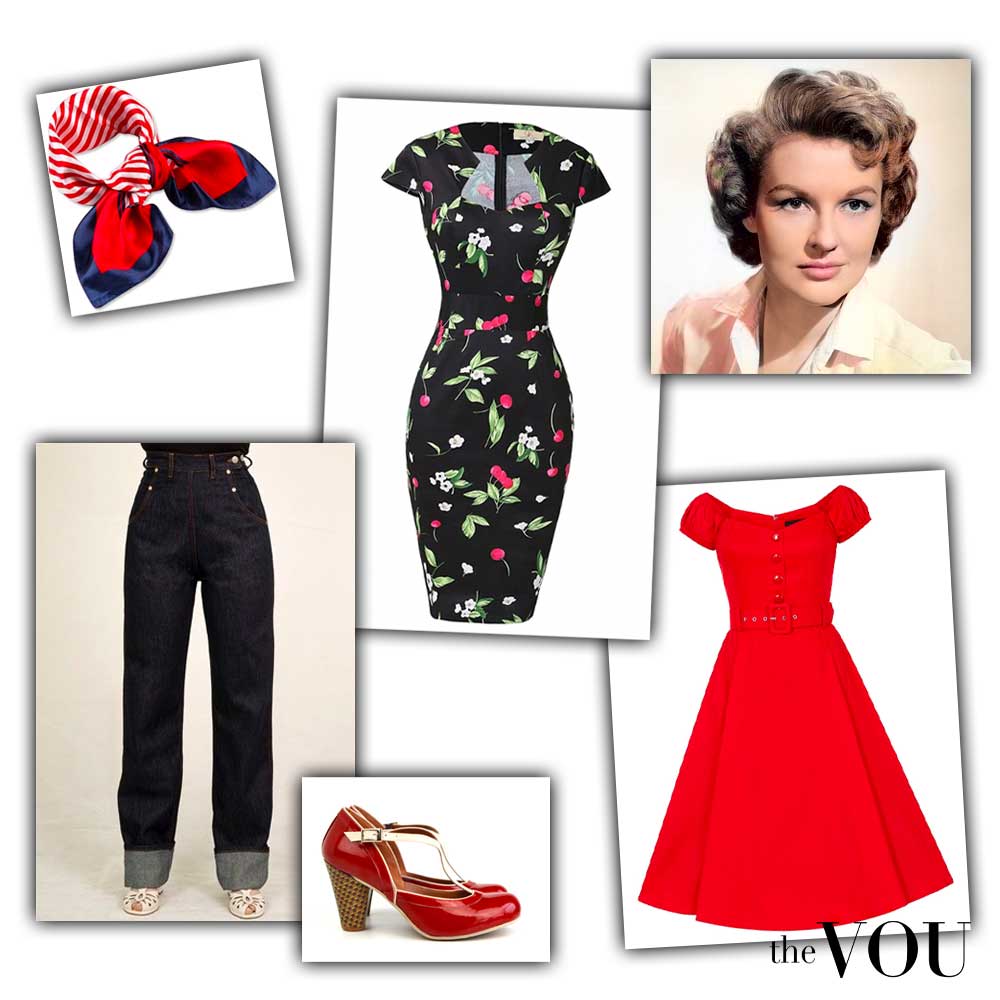
Men’s clothing included leather jackets, denim jeans, Western-style shirts, and slicked-back pompadours or short, sharp cuts.
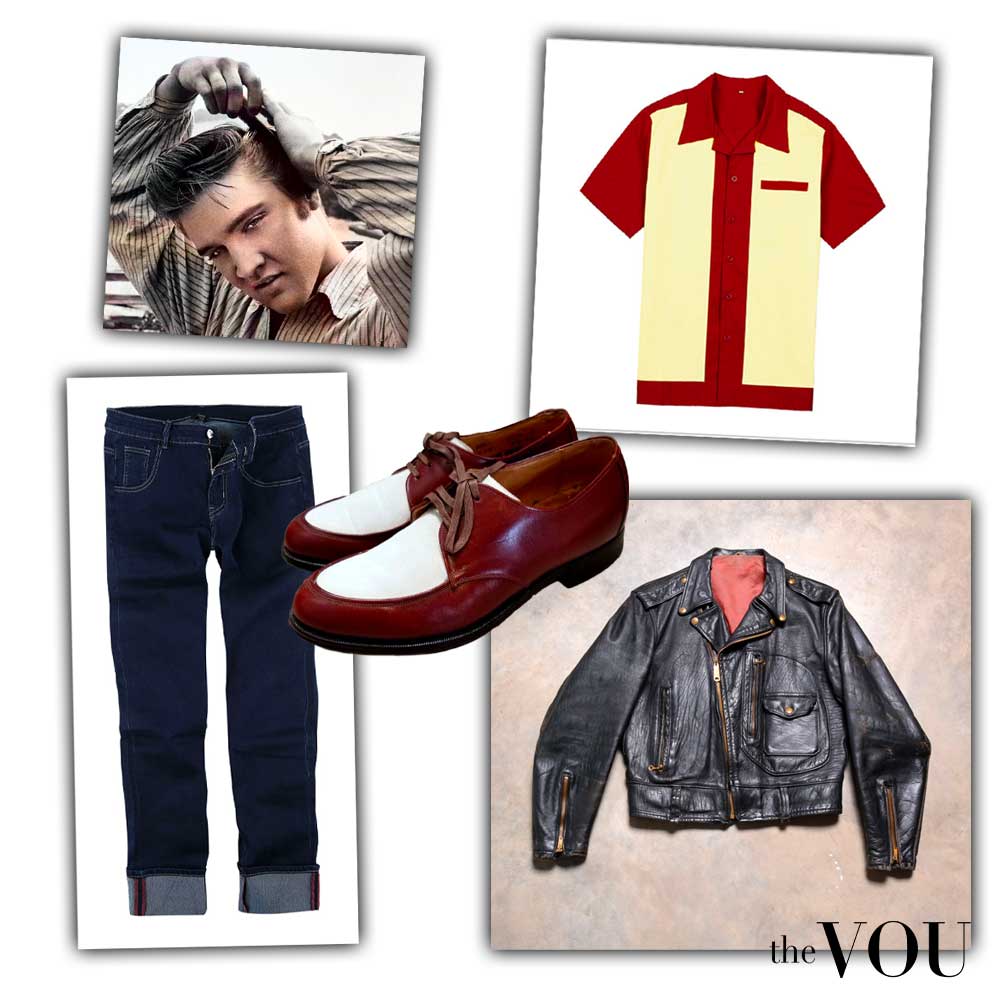
Elvis Presley and James Dean’s combos of leather jackets – once the garb of bikers and aviators – and jeans – formerly relegated to workwear – became the youths’ symbols of rebellion.
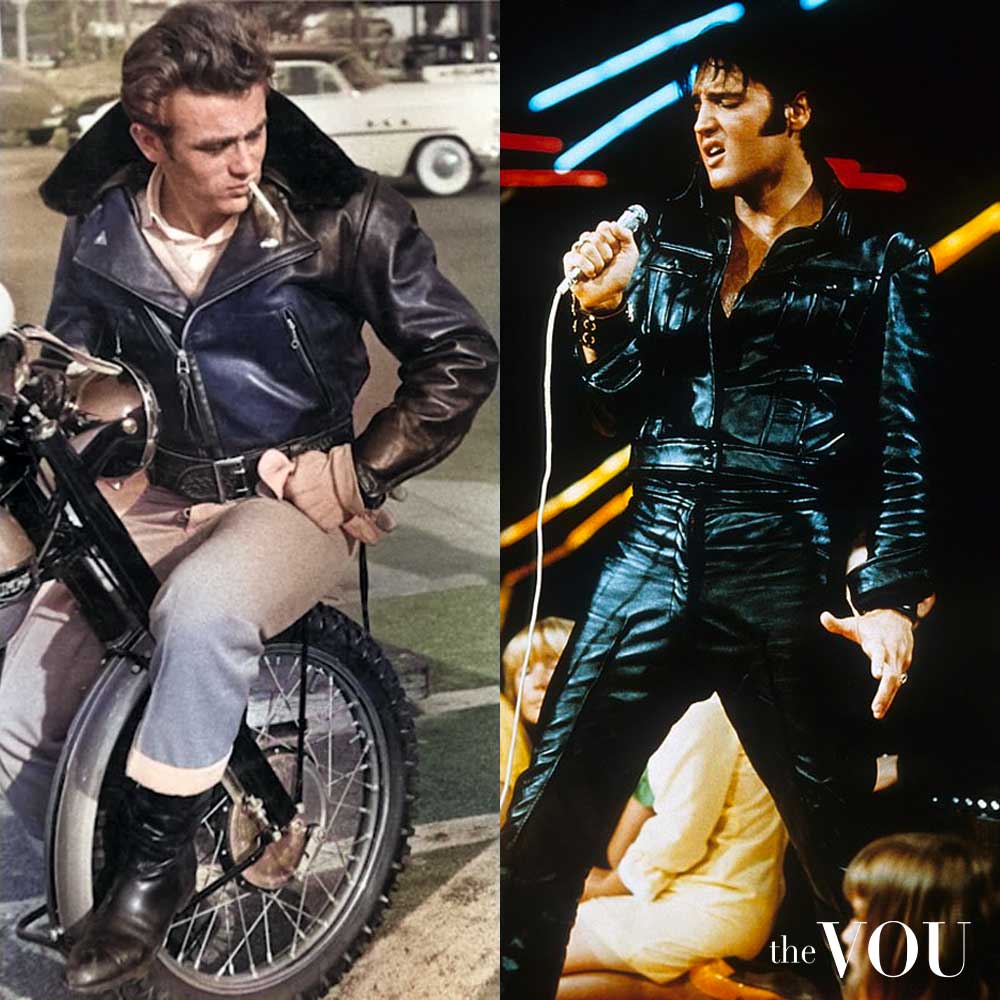
Under the impact of Rockabilly, the 1950s fashion shifted from the somber tones of the 1940s to cherry reds, bright blues, and sunny yellows, reflecting the optimistic spirit of the era.
Greaser Style
Greaser-style, a look of fitted white T-shirts, cuffed jeans, and slicked-back hair, exuding a raw and unpolished aesthetic, gained popularity in the 50s as the look of the working-class rock ‘n’ roll musicians.
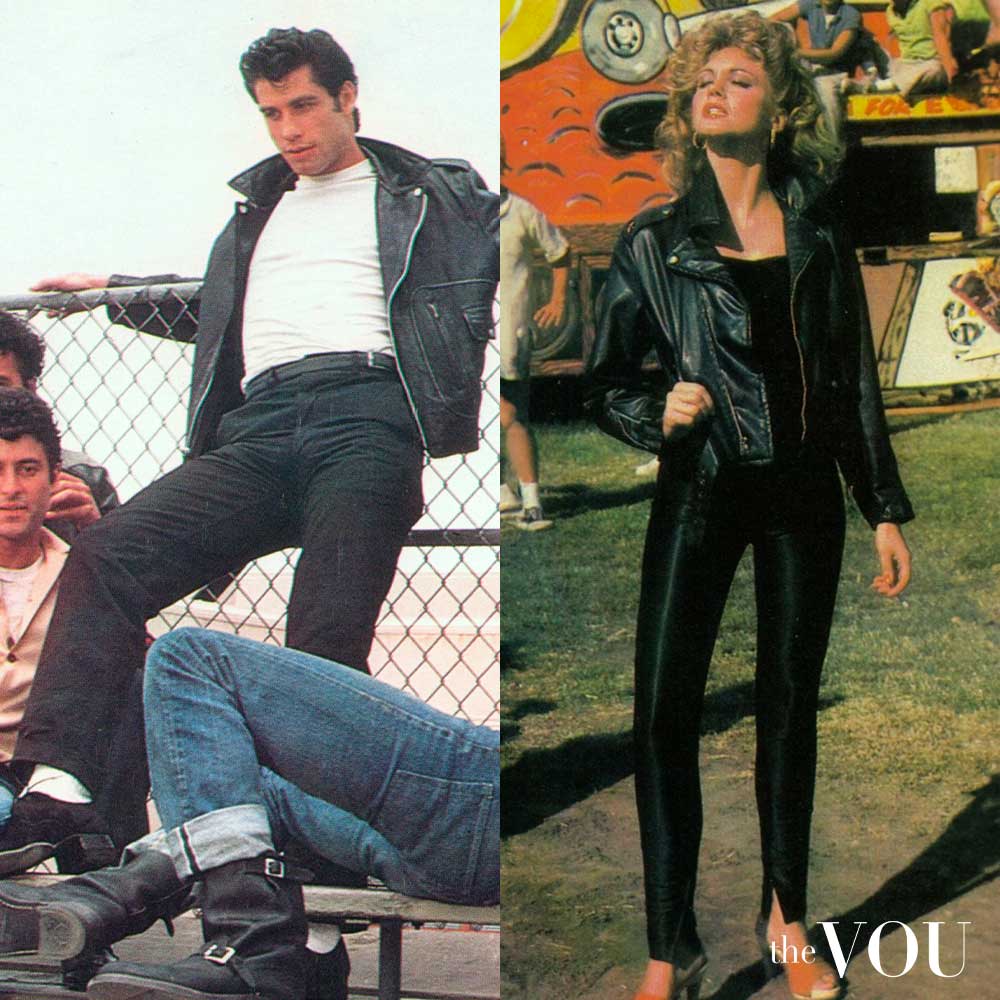
The Greaser style, epitomized by John Travolta in “Grease,” further propelled this fashion into mainstream culture. Travolta’s portrayal showcased the Greaser’s signature look with an added touch of Hollywood glamor, cementing its iconic status in rock ‘n’ roll fashion history.
Teddy Boy and Girl
As rock ‘n’ roll music permeated the airwaves, it brought a wave of change that swept the fashion world, resulting in the emergence of the Teddy Boy fashion style in Britain.
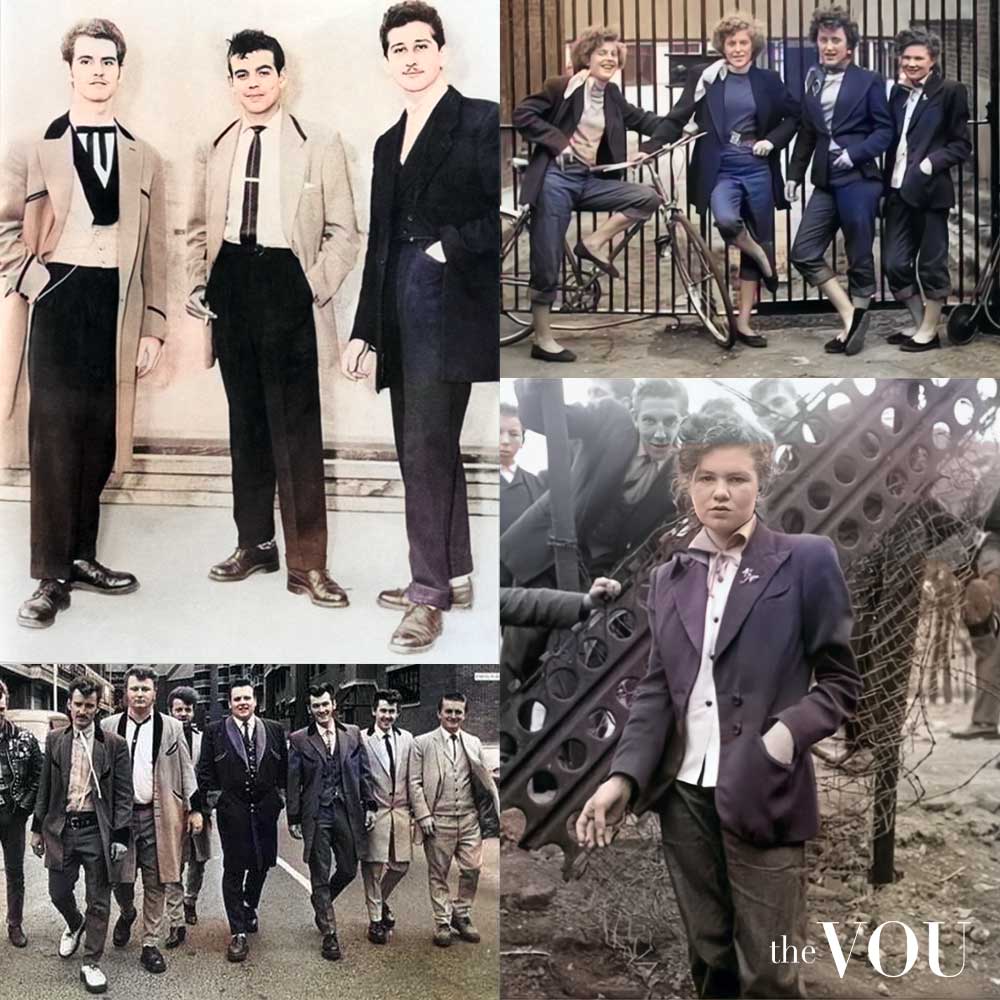
In a unique blend of Edwardian drape jackets with velvet collars, high-waist, drainpipe trousers, and brocade waistcoats, the Teddy Boy look was Britain’s interpretation of the American rock ‘n’ roll fashion.
The female counterpart to Teddy Boys, known as Teddy Girls or Judies, embraced tailored jackets, pencil skirts, rolled-up jeans, and flat shoes.
Offering a departure from the hyper-feminine outfits of stars like Marilyn Monroe or Elizabeth Taylor, Audrey Hepburn’s boyish yet feminine style became representative of Teddy Girls.
1960s – The British Rock Invasion
Driven by iconic British bands like The Beatles and The Rolling Stones, the 1960s witnessed new music and fashion styles, influencing how people dressed, behaved, and viewed the world.

British Invasion
Influenced by the so-called “British Invasion,” the 60s was a decade that reshaped the British and American rock music and fashion movements.
British Invasion was characterized by a blend of traditional British sartorial elegance and an edgier, more rebellious aesthetic.
The slim-fitting classic suits made of fine fabrics, worn by The Beatles in their early years, contrasted starkly with the casual American styles of the previous decade.
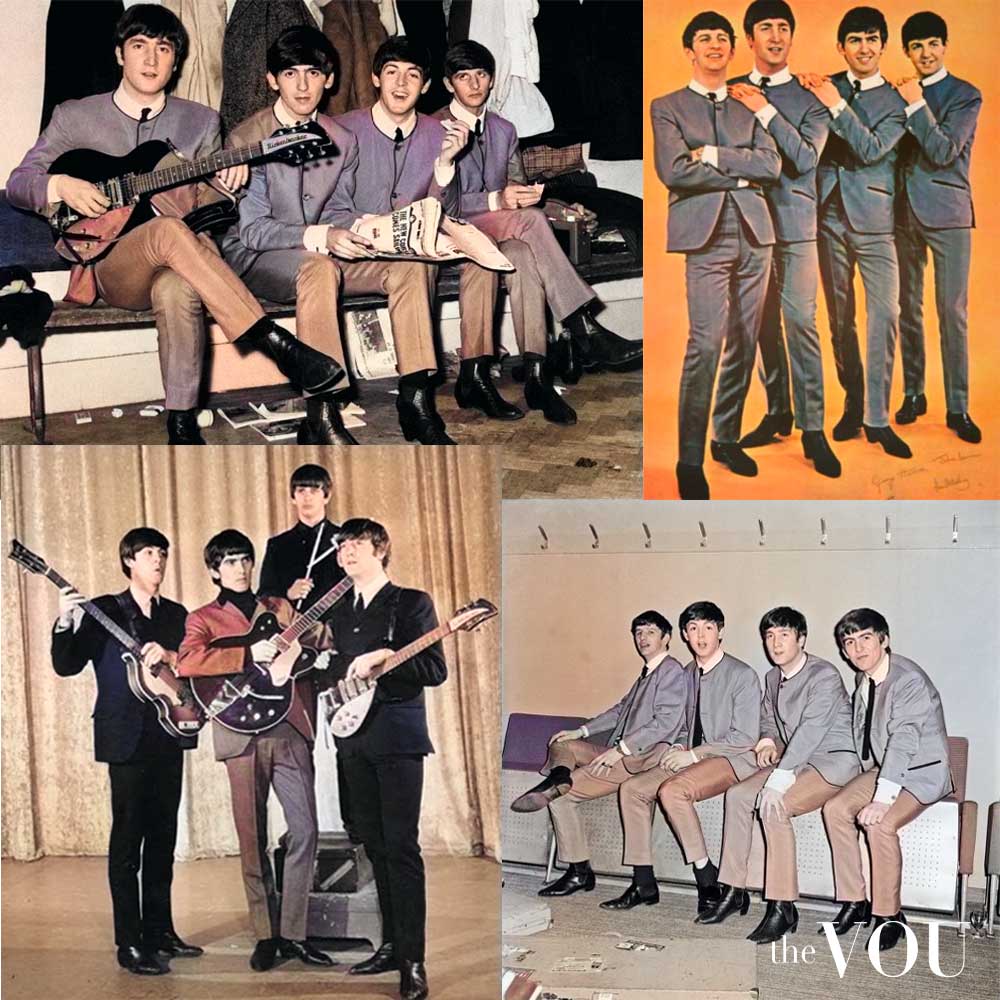
Accessorized with Chelsea boots and the “mop-top” haircuts, The Beatles suits symbolized the new, modern look of the 60s.
Rolling Stones’ long-sleeve turtlenecks, high-waistline checked trousers, striped blazers with a high-neck sweater, denim jackets, suit jackets, and Chelsea boots showcased a rare mix of British country club and American Ivy League attire.
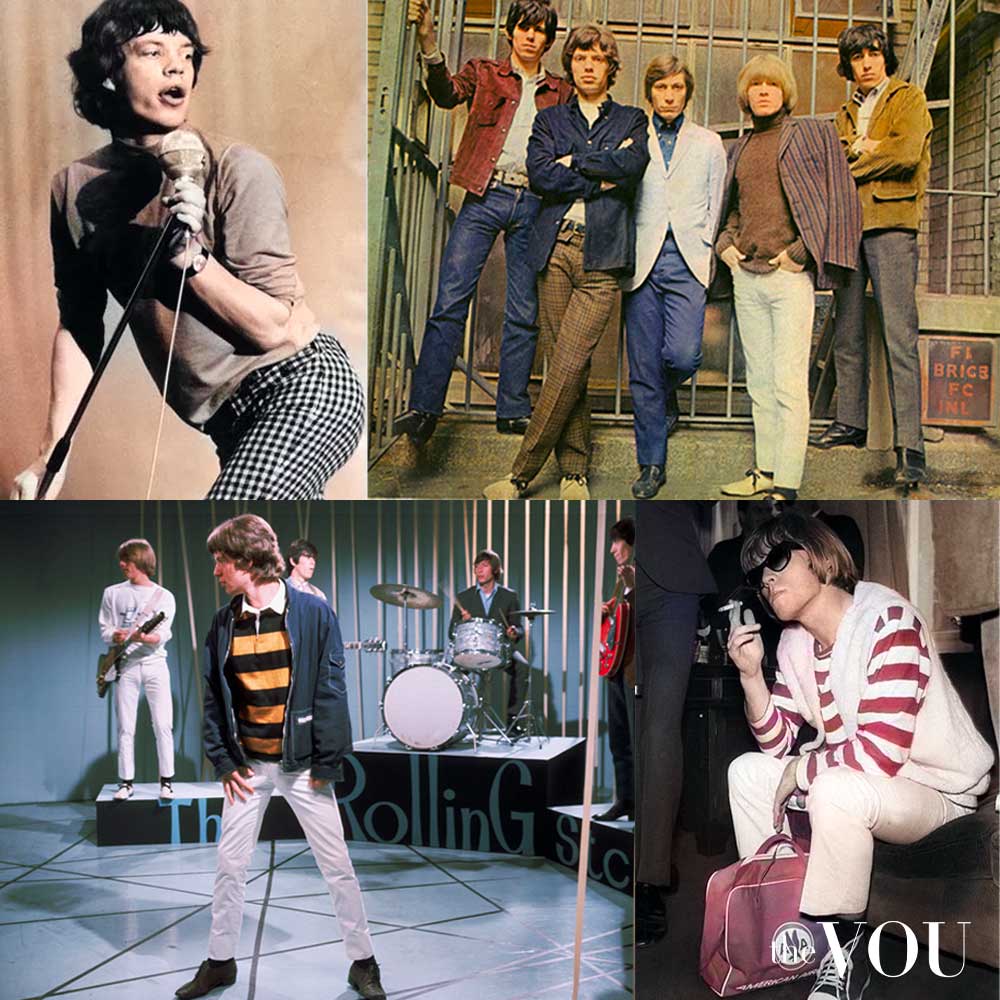
The Rolling Stone 1960s fashion styleThe British Invasion of the 1960s introduced new styles and trends that challenged the established norms, reflected the changing societal attitudes, and left an indelible mark on the fashion world.
Mod Fashion
Through bands like The Who and The Kinks, the British Invasion popularized Mod fashion – London’s youth dressing style comprised of tailored suits, polo shirts, loafers, and parkas.
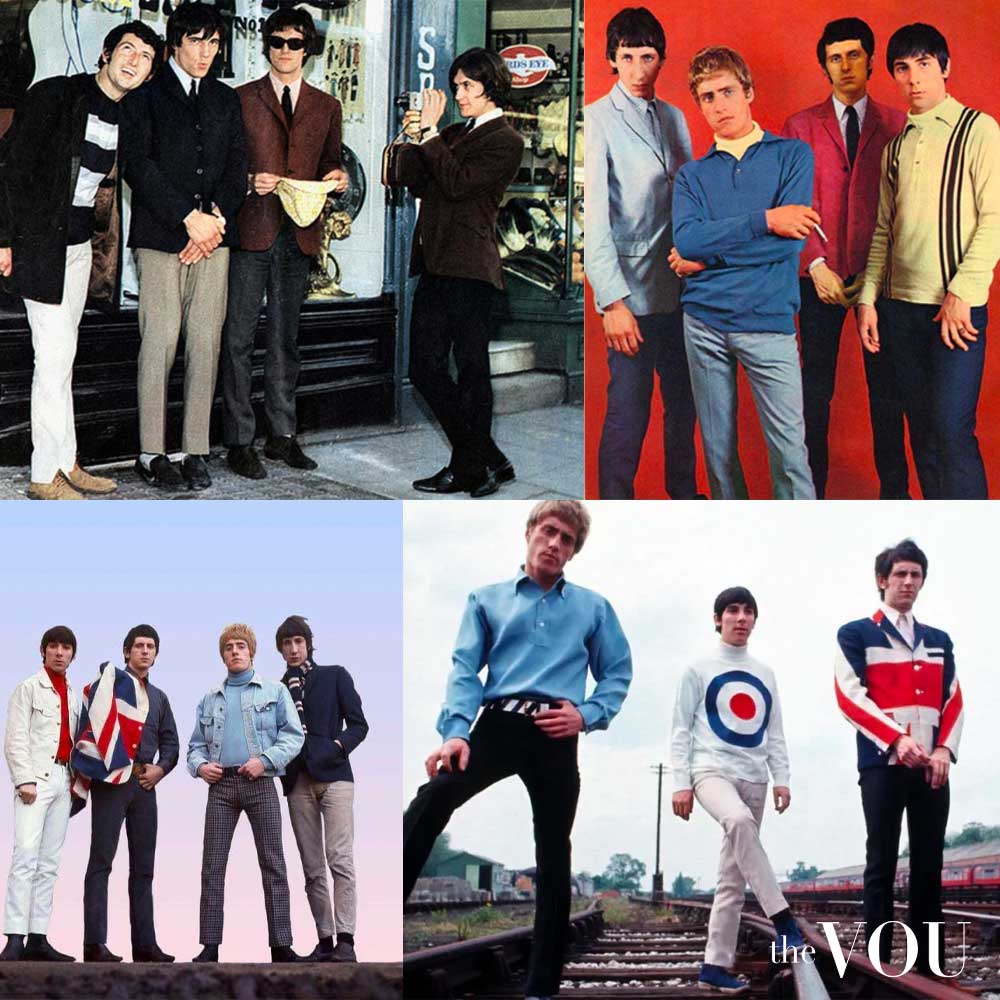
The influence of these British bands and the work of designer Mary Quan extended to women’s fashion as mini skirts paired with go-go boots became a key way of dressing in depicting the 60s spirit of liberation.
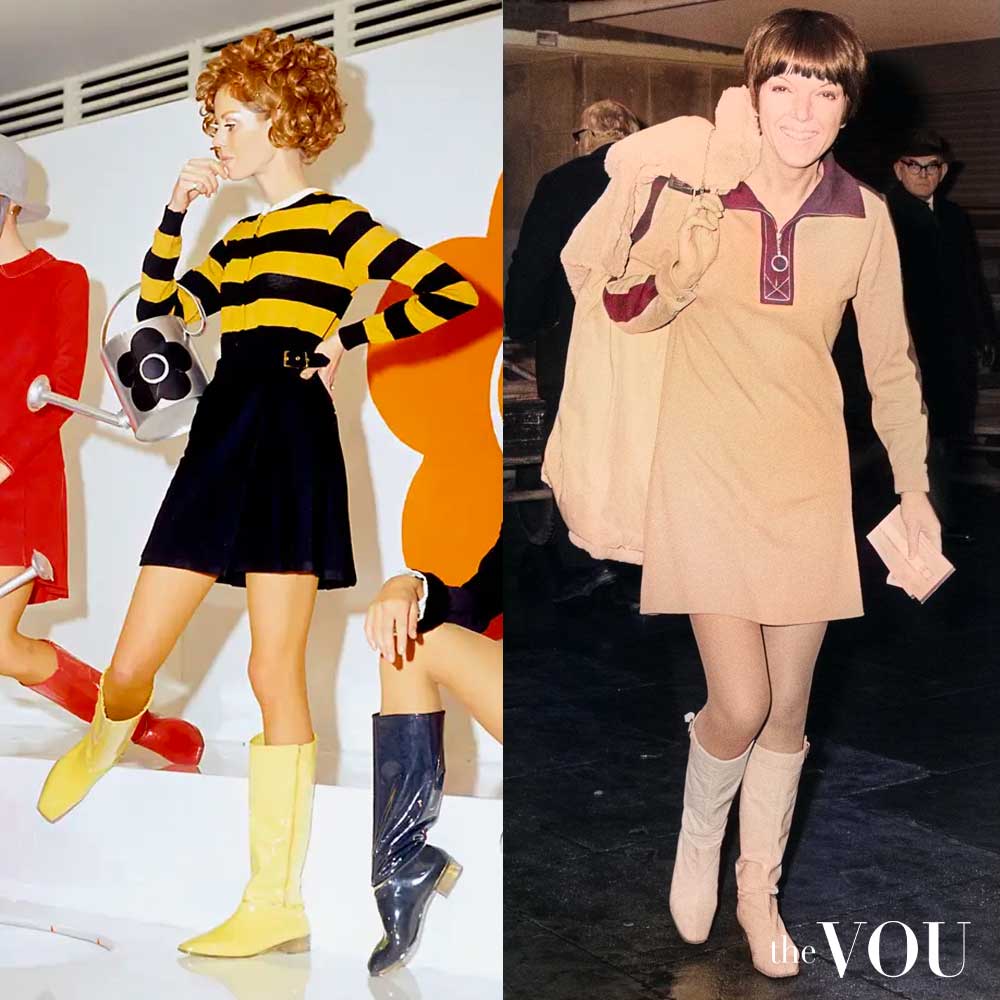
Psychedelic Rock
In the kaleidoscopic world of late 1960s Psychedelic Rock, fashion transcended into a realm of flashy expression, with artists donning garments that echoed their experimental music.
Yardbirds’ members, like Jeff Beck and Jimmy Page, embraced the Psychedelic Rock fashion by wearing outfits combining electric blues and vibrant purples with paisley patterns, psychedelic motifs, and floral motifs.
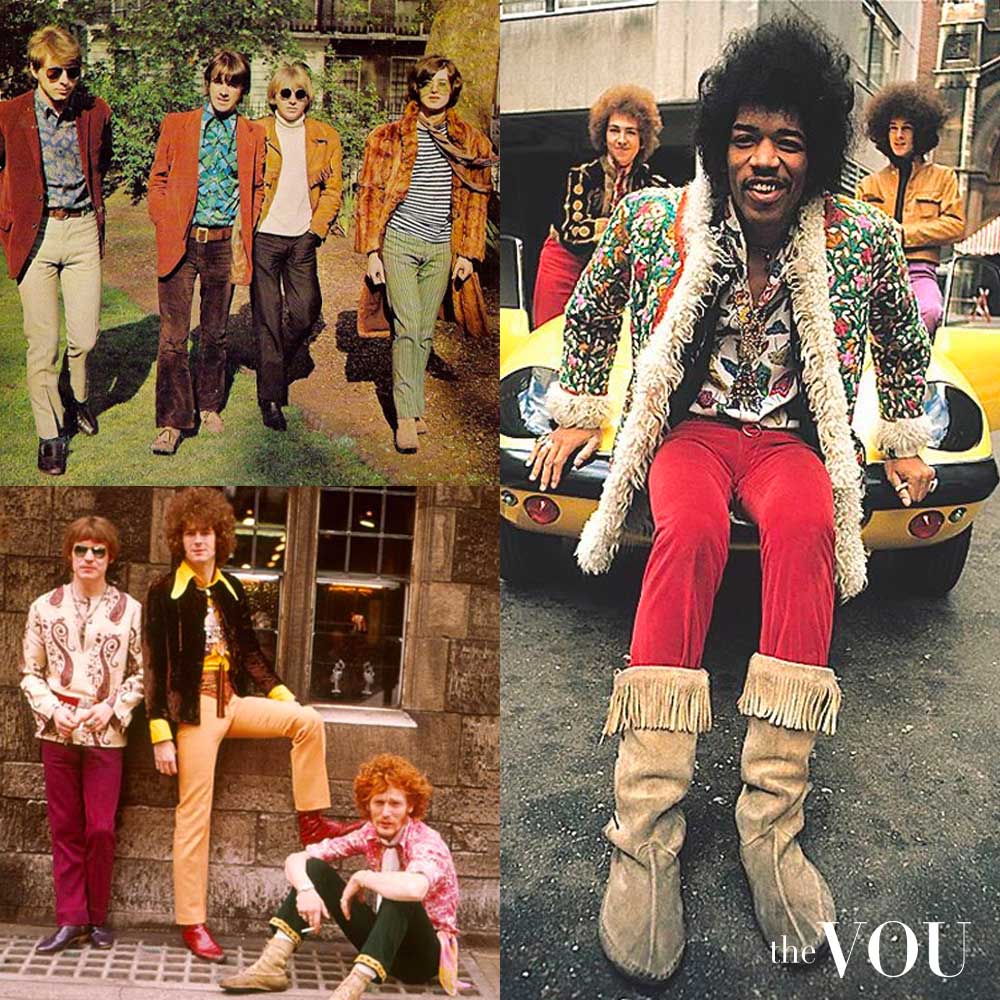
Similarly, Jimi Hendrix, Eric Clapton, and The 13th Floor Elevators showcased amazing Psychedelic fashion by wearing Bohemian-inspired colorful shirts with paisley patterns, flared pants, embroidered velvet jackets, colored scarves, wide-brimmed hats.
1970s – Glam Rock and Punk
Glam Rock
Characterized by shiny clothing, androgynous silhouettes, and glittery makeup, the Glam rock fashion emerged in the 1970s and depicted a blend of rebellion, theatrics, androgyny.
The Glam Rock look was popularized by artists like Marc Bolan of T. Rex, Roxy Music, Slade, and David Bowie’s Ziggy Stardust persona through stretchy polyester jumpsuits, theatrical silk sleeves tops with sequins and cropped backs, bell bottoms, and skinny midriffs tops with flared jeans.
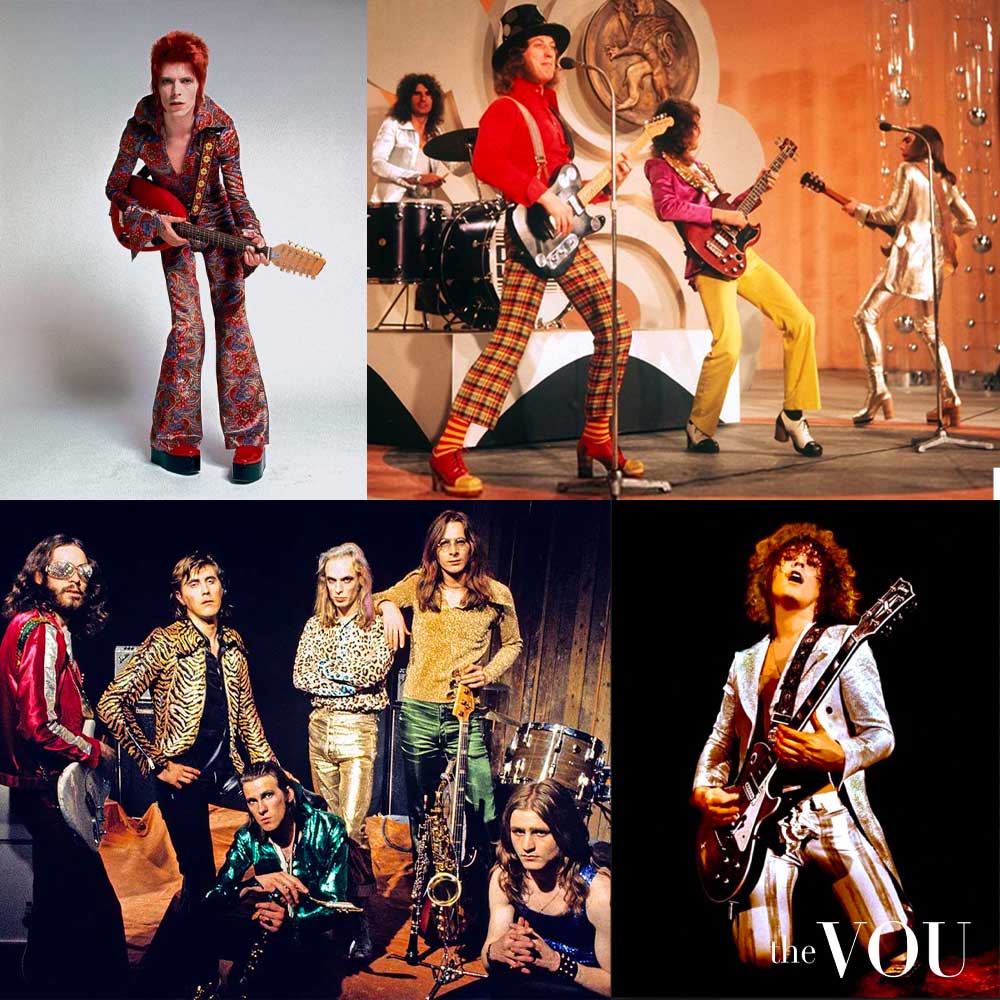
The look drew aesthetic influences from the 1930s Hollywood glamour, Victorian styles, SCI-FI themes, and psychedelic and art rock of the late 1960s.
The Runaways and Suzi Quatro personified Glam Rock fashion in the 1970s with their form-fitting jumpsuits.
Cherie Currie’s metallic silver outfit with high-heeled boots and Suzi Quatro’s metallic, gold, and red jumpsuits with zippers highlighted the era’s penchant for shimmer and shine.
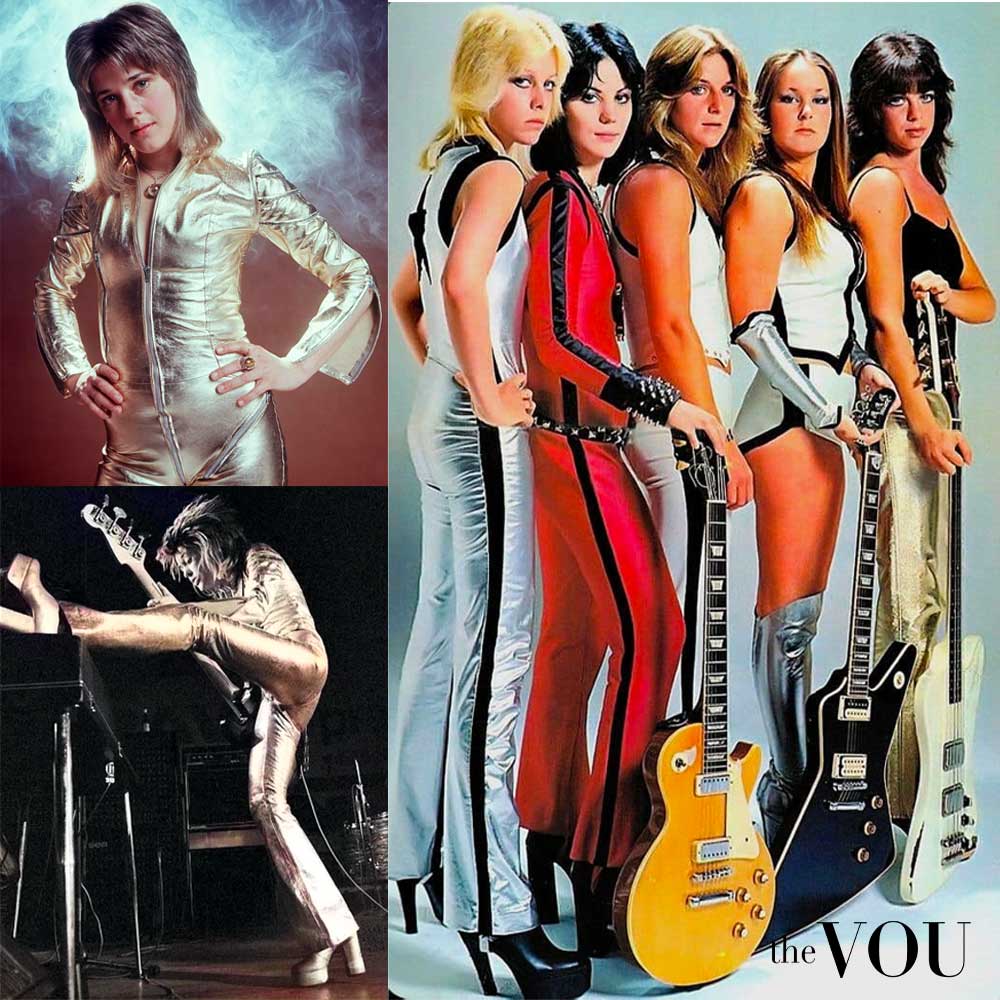
Punk Rock
Driven by a DIY ethos and a raw, edgy look spearheaded by bands like the Sex Pistols, The Ramones, and The Clash, Punk fashion emerged in stark contrast to Glam rock style.
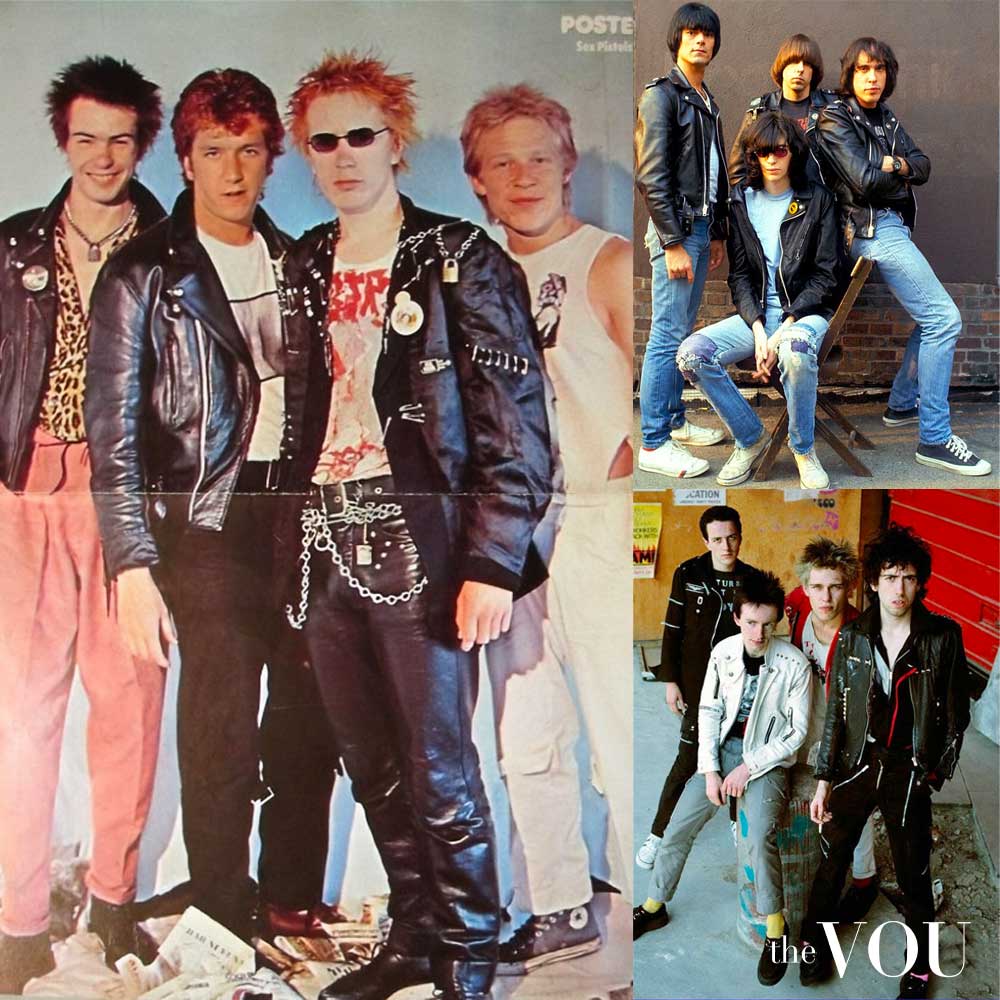
With body-conscious mesh tops, leather mini skirts, and fishnet stockings matched with studded belts and cuffs, Punk female icons like Blondie, The Slits, Plasmatics, and Lydia Lunch brought a fierce and avant-garde aesthetic to the forefront of the movement.
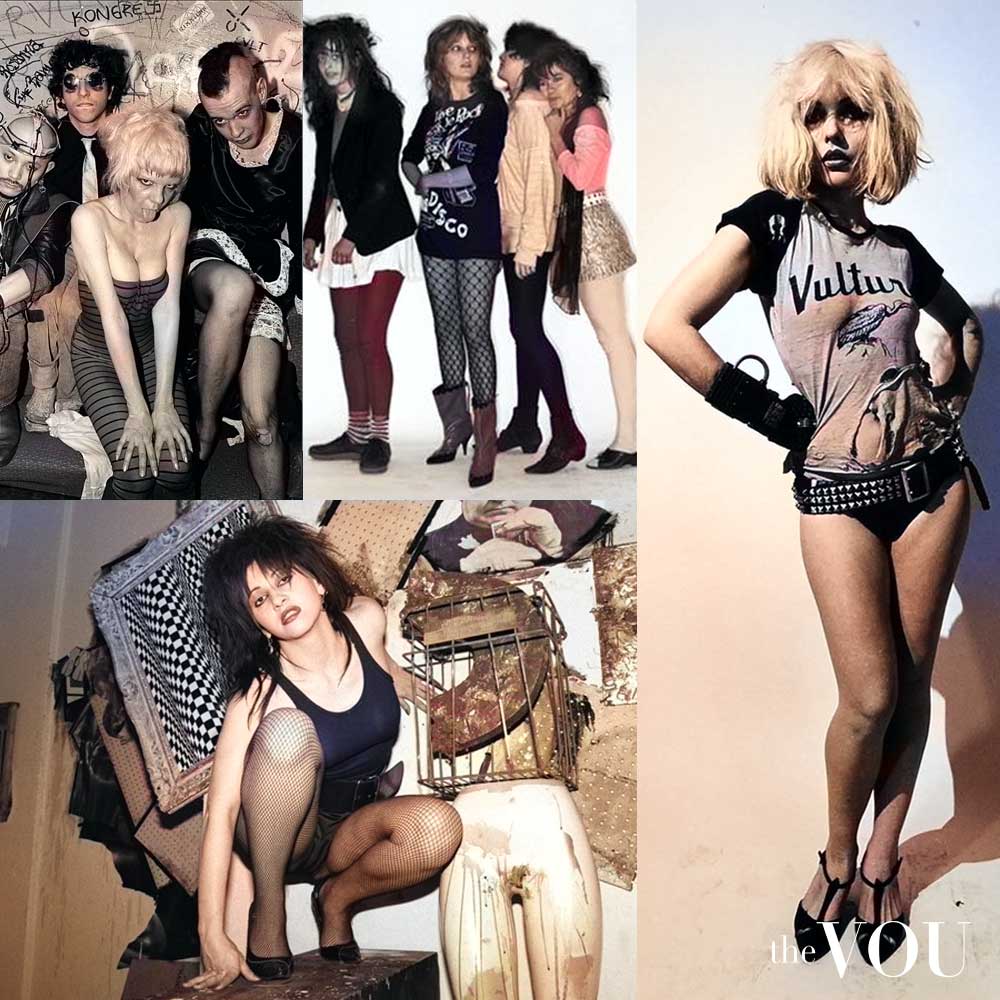
Characterized by distressed leather jackets, ripped denim, tees with anti-establishment slogans, combat boots, spikes, studs, chains, and safety pins, the late 70s and 80s Punk style signified a rejection of societal norms.
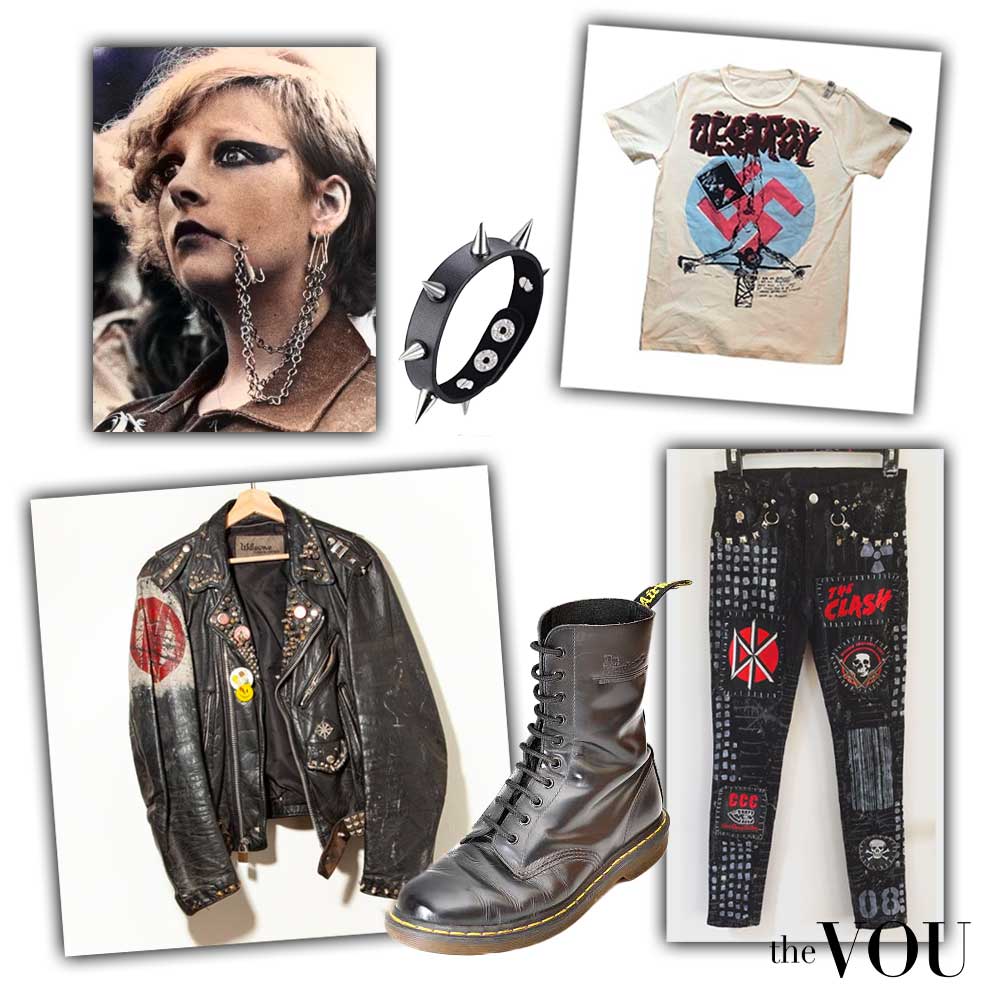
With a profound impact on culture and society, the legacy of Glam Rock and Punk continues to inspire modern fashion, with contemporary artists and designers drawing inspiration from the bold and rebellious spirit of the 1970s.
1980s – Metal and Goth Rock
Heavy Metal
Bands like Black Sabbath and Led Zeppelin laid the groundwork in the late 1960s and early 1970s for what would later become Heavy Metal, but the fashion materialized in the 80s.
Driven by bands like Metallica, Slayer, Judas Priest, Megadeth, and Iron Maiden, the intense and powerful sound of Heavy Metal was mirrored by the decade’s styles.
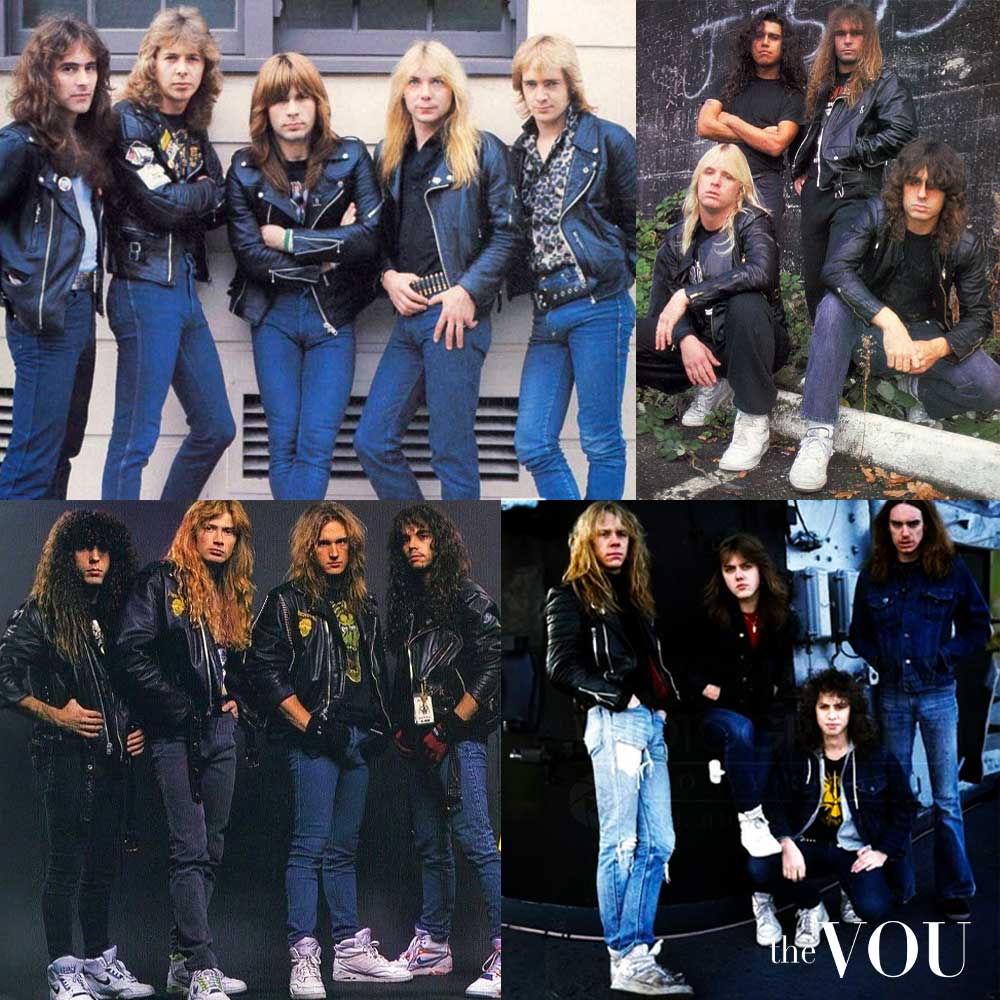
With leather vests, tight denim, layered bracelets, chains, and studded accessories, ’80s Heavy Metal female bands like Girlschool, Rock Goddess, and Doro Pesch shattered gender norms with their sartorial choices.
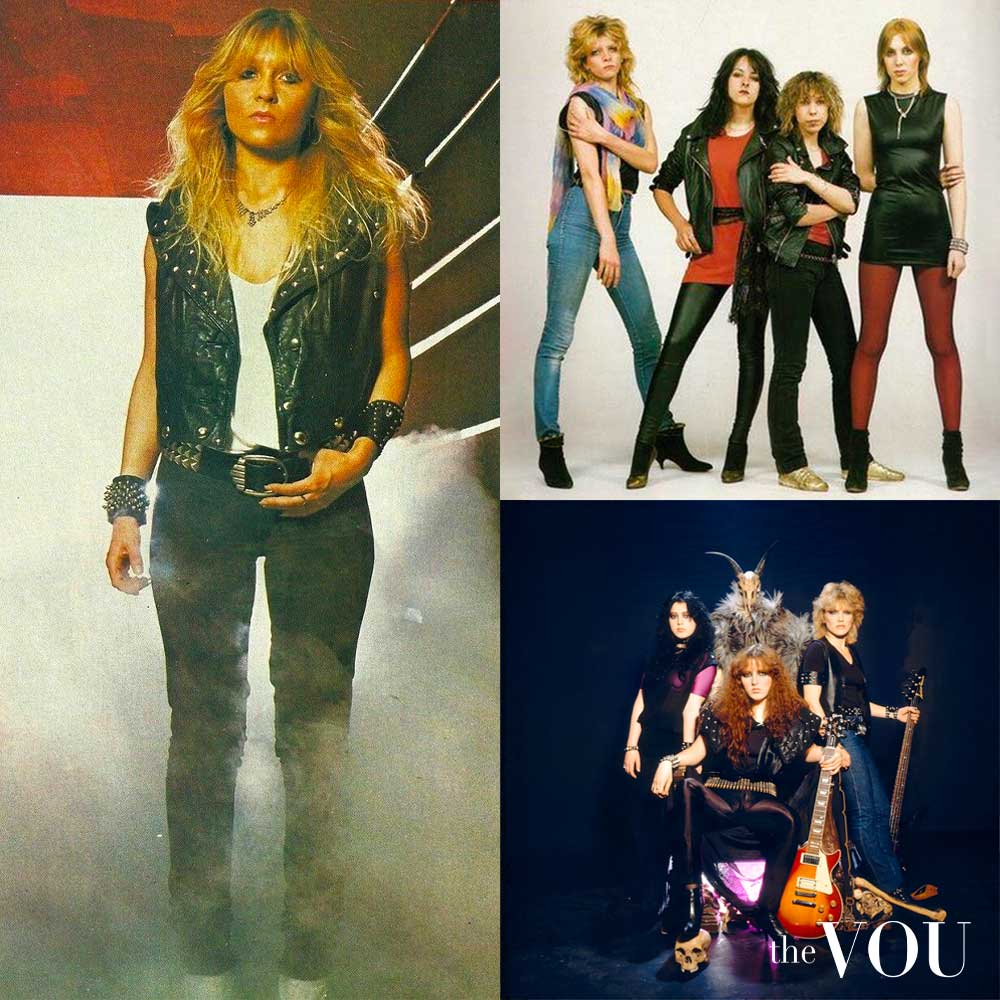
Hailing masculinity ethos while rejecting the emerging metrosexual culture, metalheads wore skinny jeans, vests, and tees with warrior motifs from Celtic, Saxon, and Viking cultures.
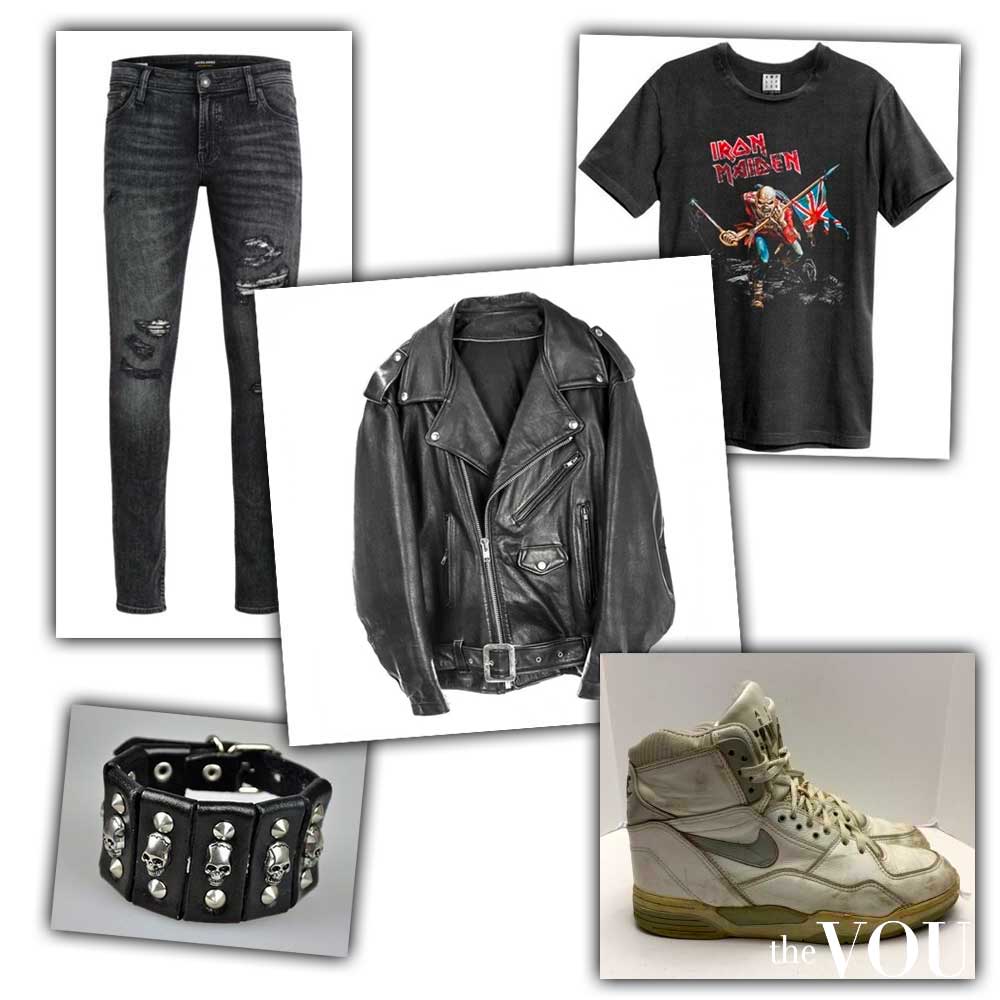
Glam Metal
Bands like Mötley Crüe, Guns N’ Roses, and Vixen introduced a Glam Metal sound while showcasing an androgynous look comprised of spandex trousers, leather chaps, bandanas, and tees with animal prints.
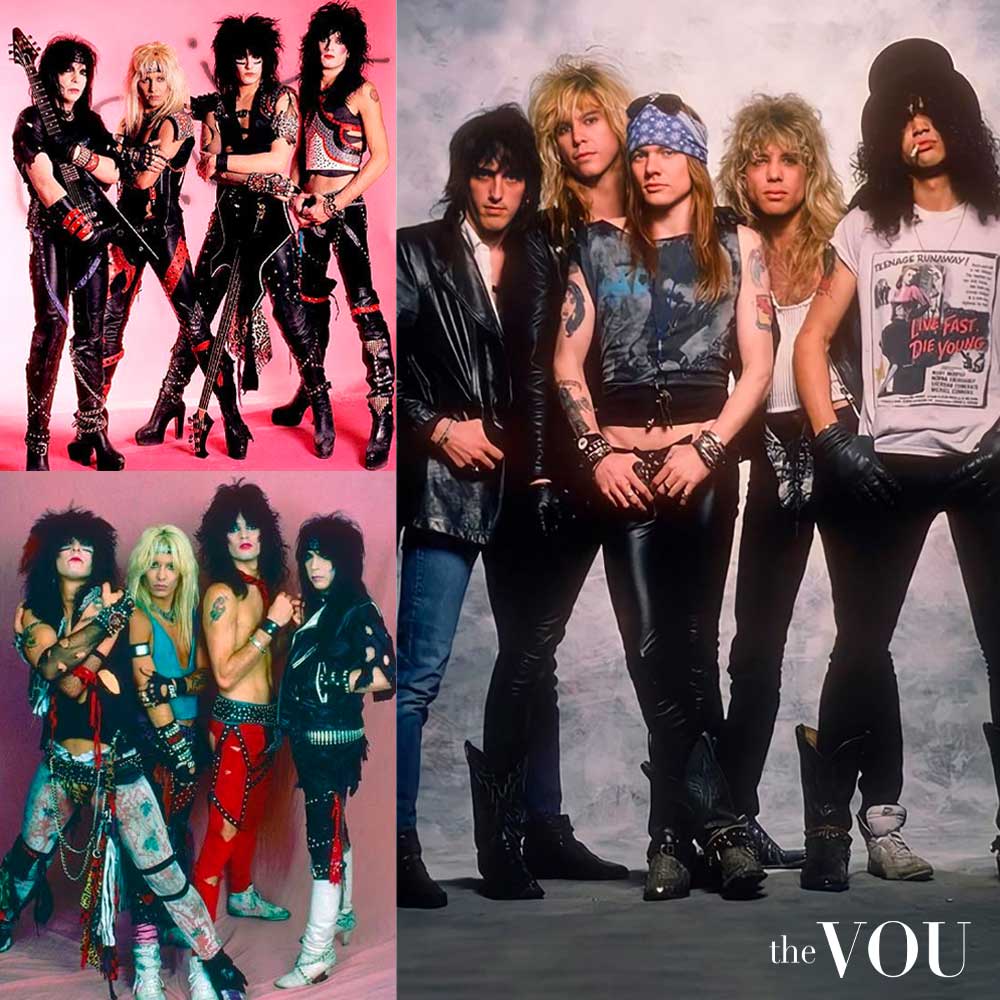
Goth
In parallel, Goth bands inspired by the post-punk scene, like The Cure, Siouxsie and the Banshees, Bauhaus, Sisters of Mercy, and Joy Division, adopted a look in stark contrast to Heavy Metal fashion.
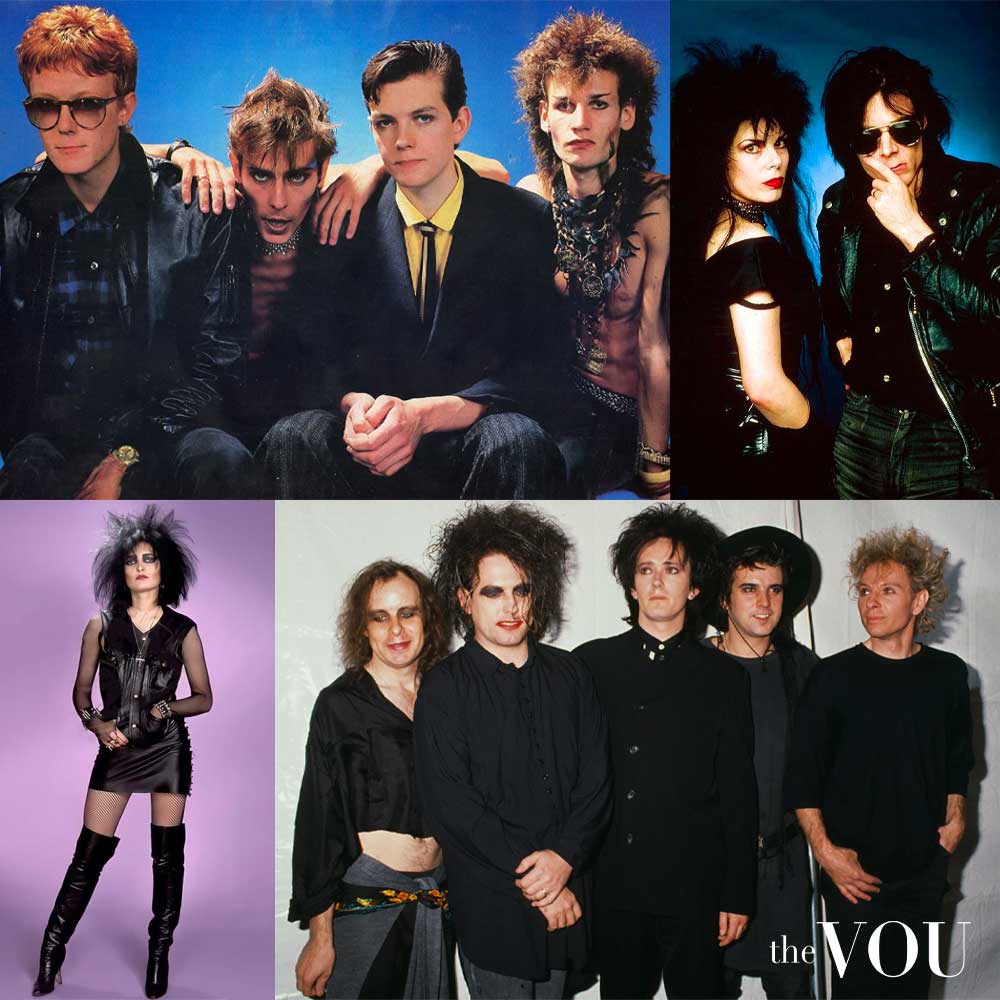
Influenced by the gothic architecture, macabre literature, and horror films, Goth fashion style comprised black Victorian-style lace and velvet garments, Doc Martens boots, deep red corsets, t-shirts with moons, stars, skulls, skinny pants, and pale foundation with dark eye makeup for a mysterious, dramatic look.
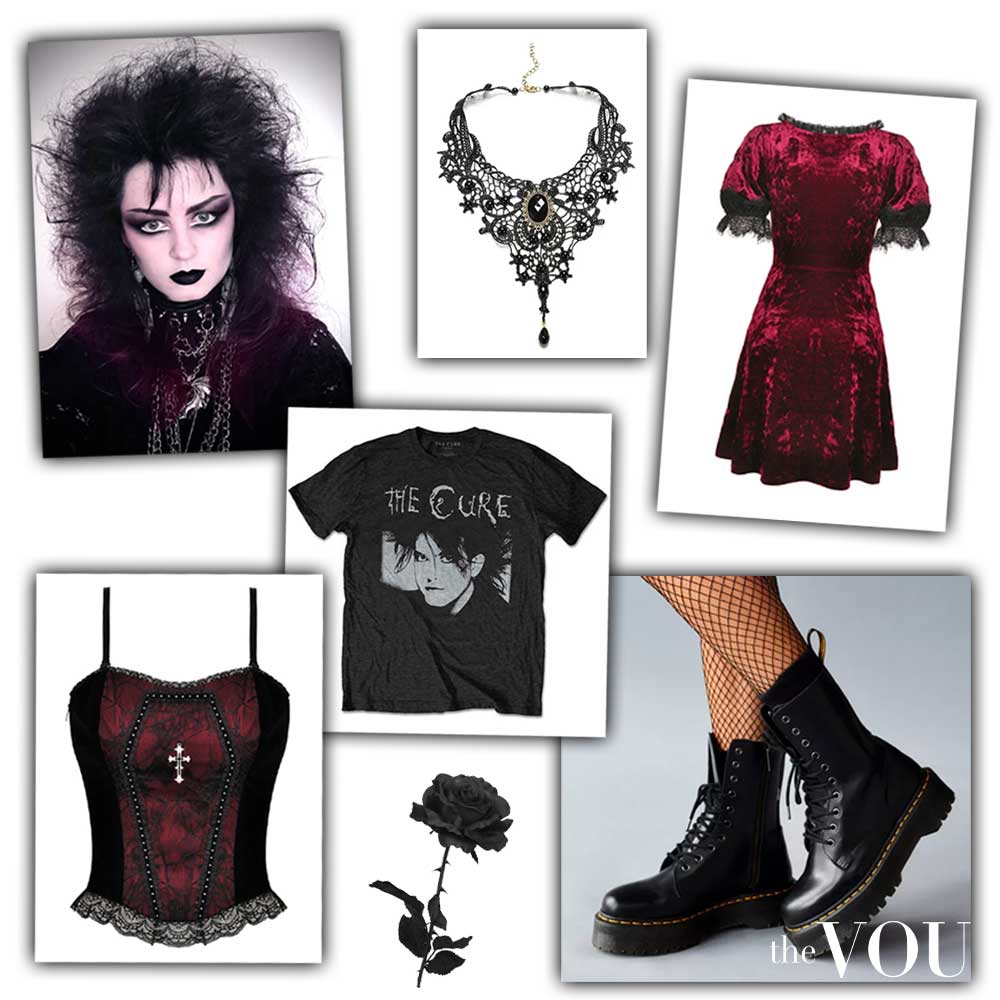
Goth chokers, bracelets, and rings were ornate with ankhs, pentagrams, and similar symbols associated with the supernatural or the macabre, adding to the mysterious allure of the Goth style.
1990s – Grunge and Britpop
Characterized by the contrasting styles of Grunge and Britpop, the 1990s were a defining era for the Rock movement.
Reflecting the underlying philosophies of each music genre – Grunge’s disdain for materialism and Britpop’s emphasis on refinement – both movements influenced the fashion trends of the 1990s.
Grunge
Rooted in the American Northwest music scene of the early ’90s, the Grunge style had a distinct anti-fashion, beauty, and glamour approach.
Grunge popularized flannel shirts, combat boots, floral dresses matched with rugged footwear, and band t-shirts with torn jeans.
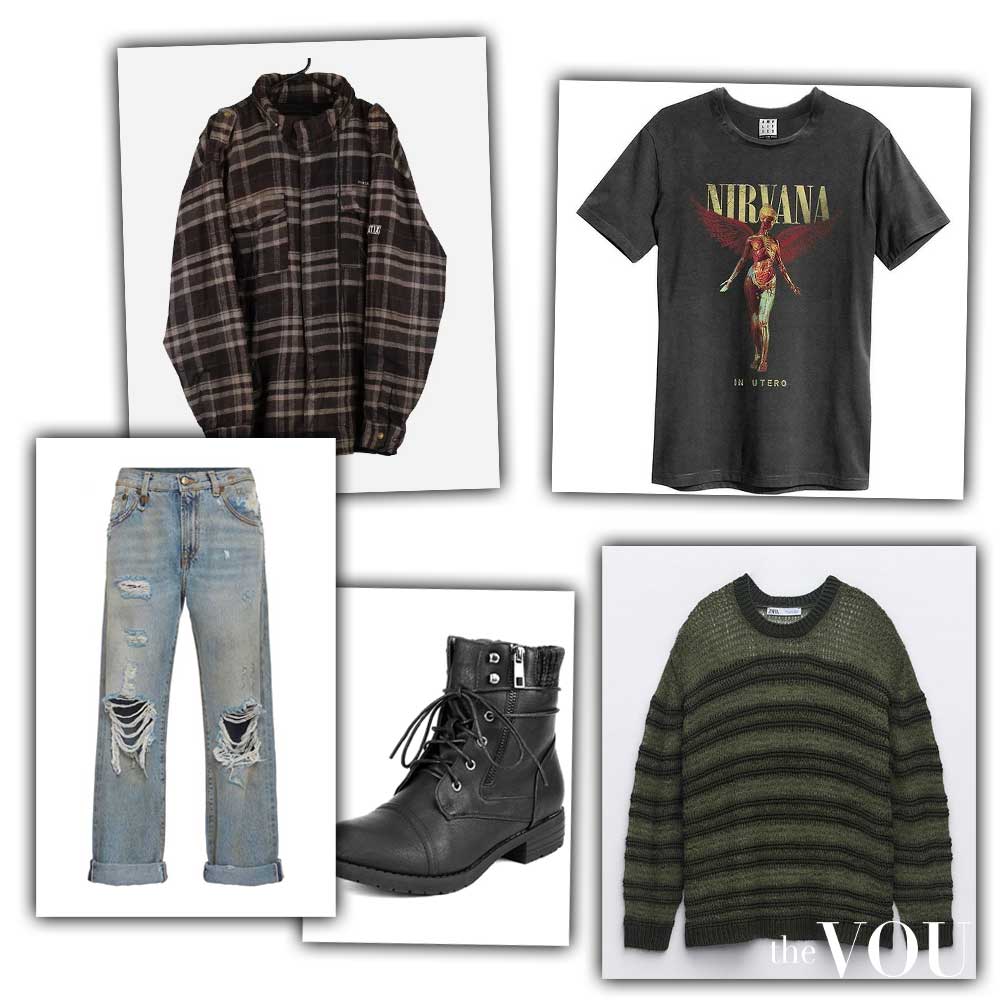
Kurt Cobain’s (Nirvana) iconic ripped jeans, oversized striped sweaters, Converse sneakers, and Eddie Vedder’s (Pearl Jam) layered flannel shirts, loose jeans, combat boots, and unkempt hairstyle became emblematic of the carefree and nonchalant attitude of the Grunge aesthetic.

Layne Staley’s (Alice in Chains) choice of black clothes, bandanas, and sunglasses added a darker, somber dimension to Grunge fashion, or Chris Cornell’s (Soundgarden, Audioslave) mix of classic Grunge with leather jackets conferred Grunge style outfits with a raw and edgy vibe.
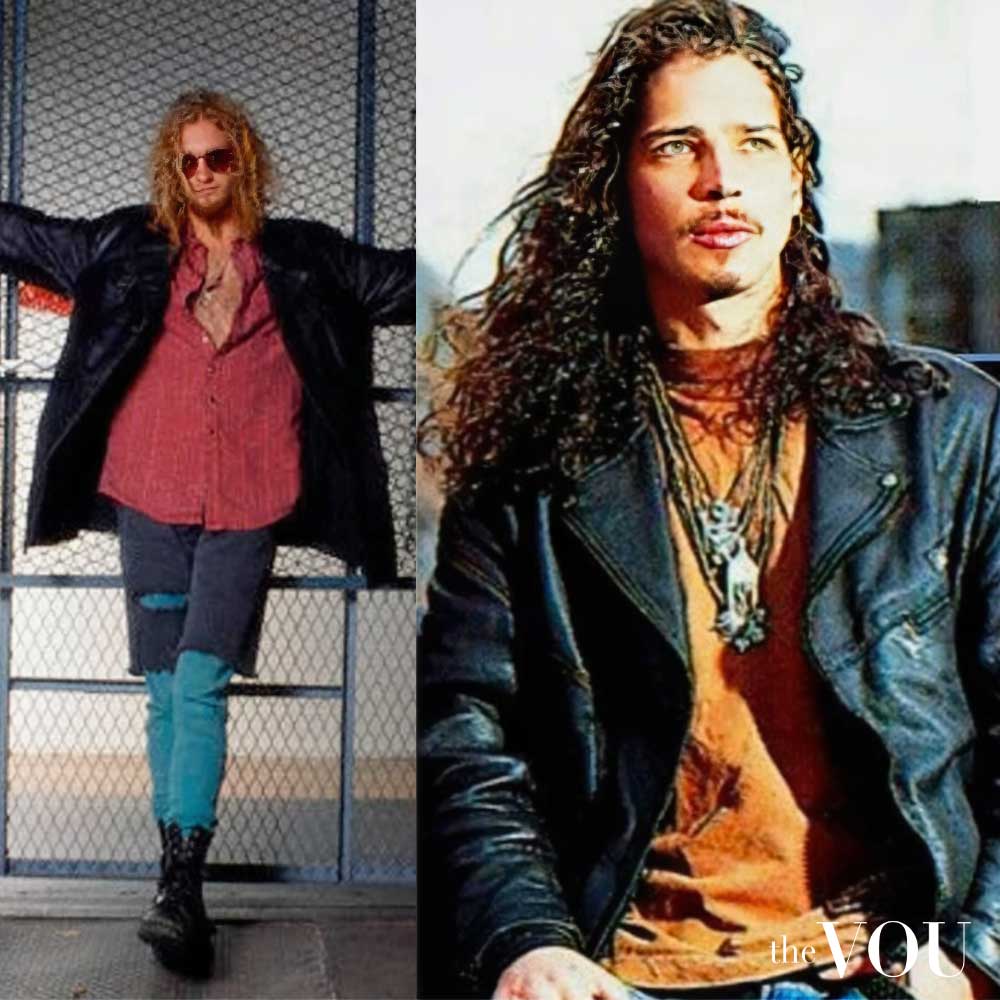
Kinderwhore
Substyles emerged as influenced by the Grunge movements, such as Courtney Love’s “Kinderwhore” look comprised of barrettes, ripped tights, slips, tiaras, and Mary Janes conferring Grunge fashion a vulnerable facet.
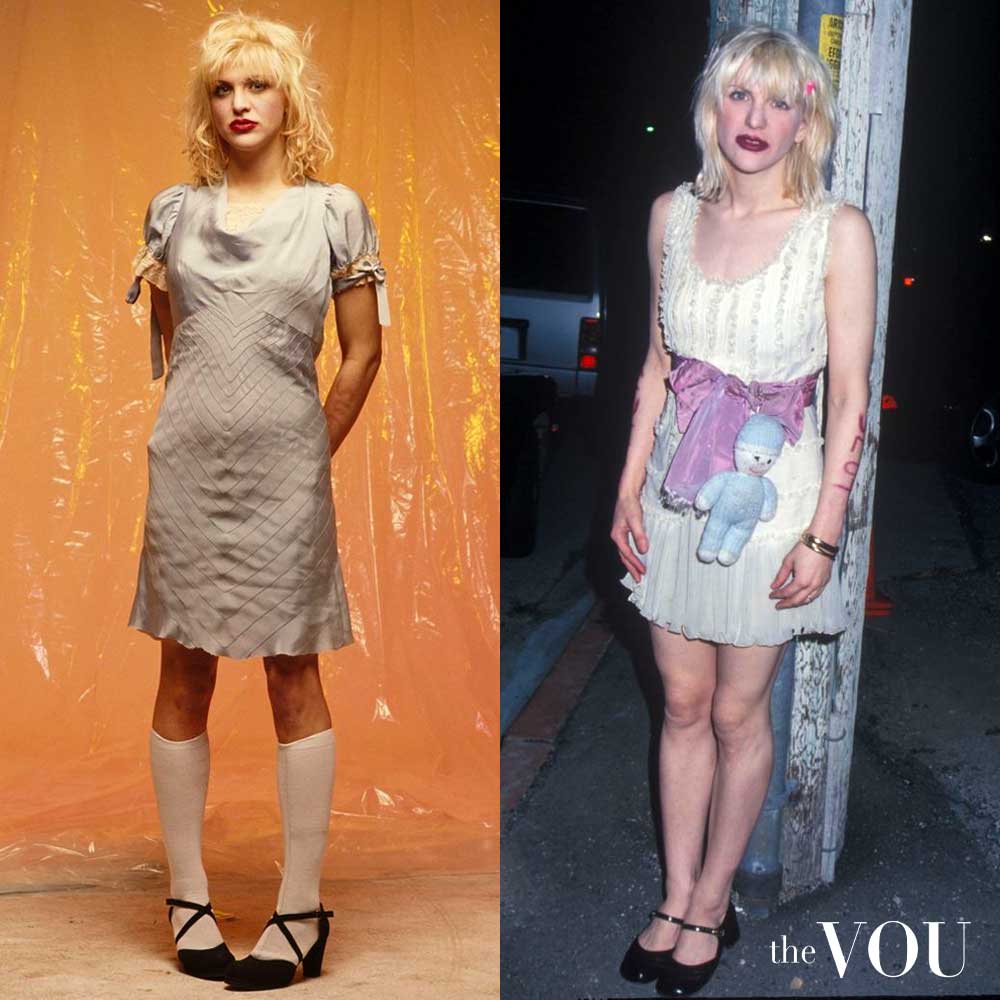
Riot Grrrl
Epitomized by bands like Bikini Kill, Bratmobile, and Sleater-Kinney, the Riot Grrrl movement of the 1990s was as much a musical statement as a fashion and cultural one.
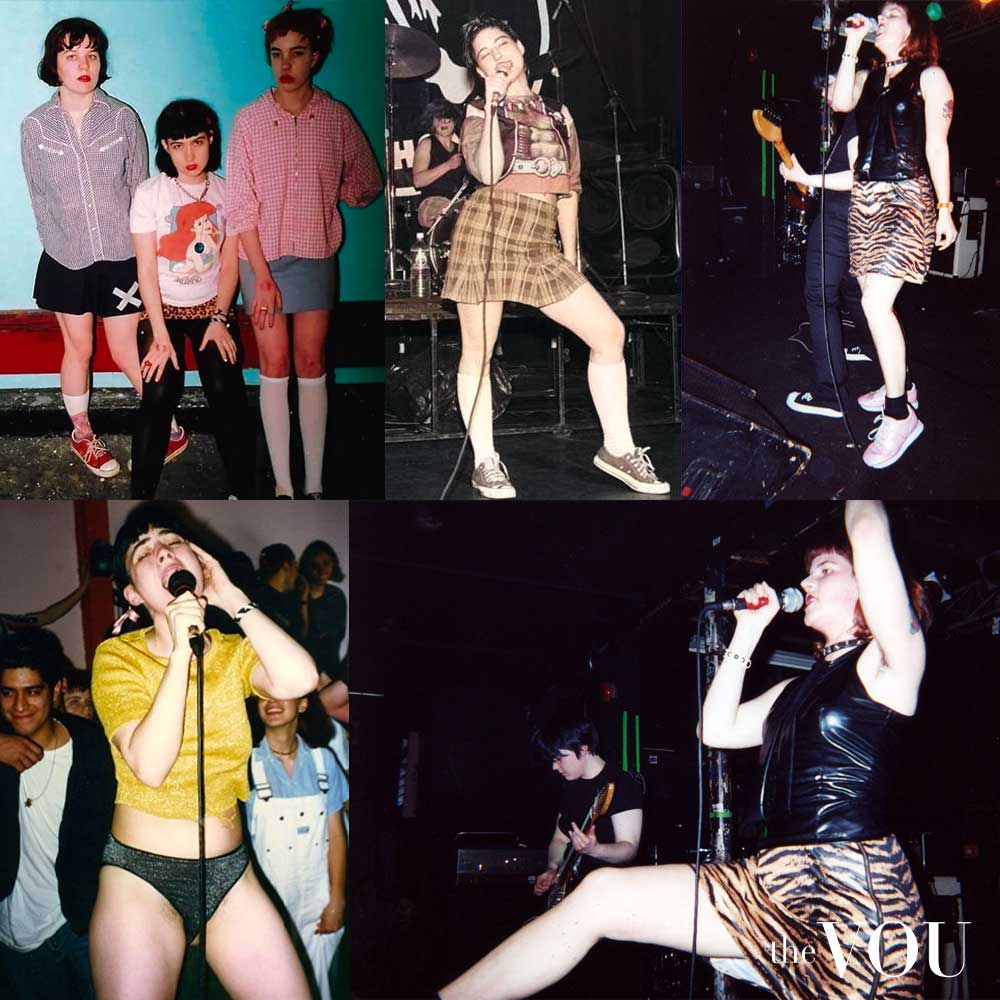
With hairy armpits, distressed Preppy-style (or animal prints) mini skirts, male shirts, leather vests, and Converse shoes accessorized with childlike accessories, Riot Grrrls defied gender norms and depicted confrontational femininity.
Britpop
While Cobain’s Grunge was a mix of masculine and feminine garments depicting a rebellious and nostalgically romantic image, across the pond in the UK, bands like Oasis and Blur adopted a Britpop look.
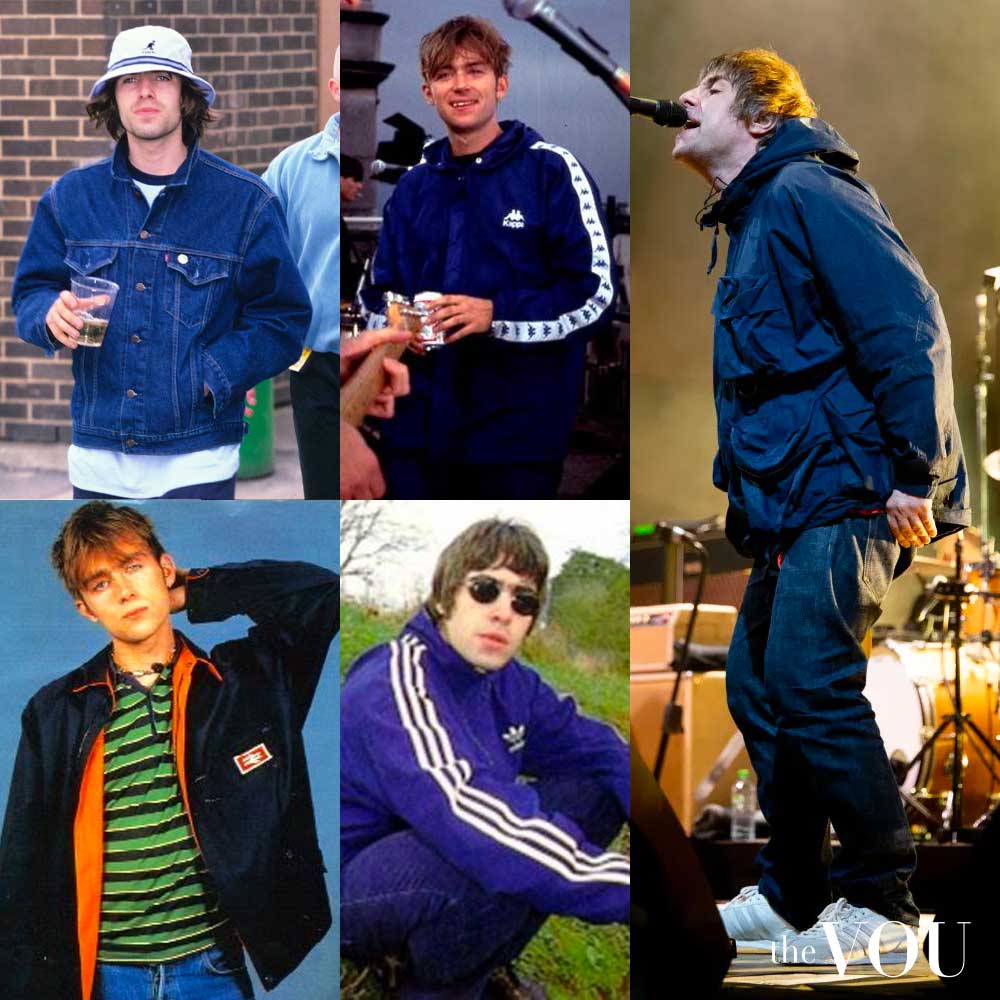
The Gallagher brothers (Liam and Noel, members of the band Oasis) and Damon Albarn, the lead vocalist of Blur, played a significant role in shaping Britpop’s aesthetic that contrasted with the Grunge style of the same era.
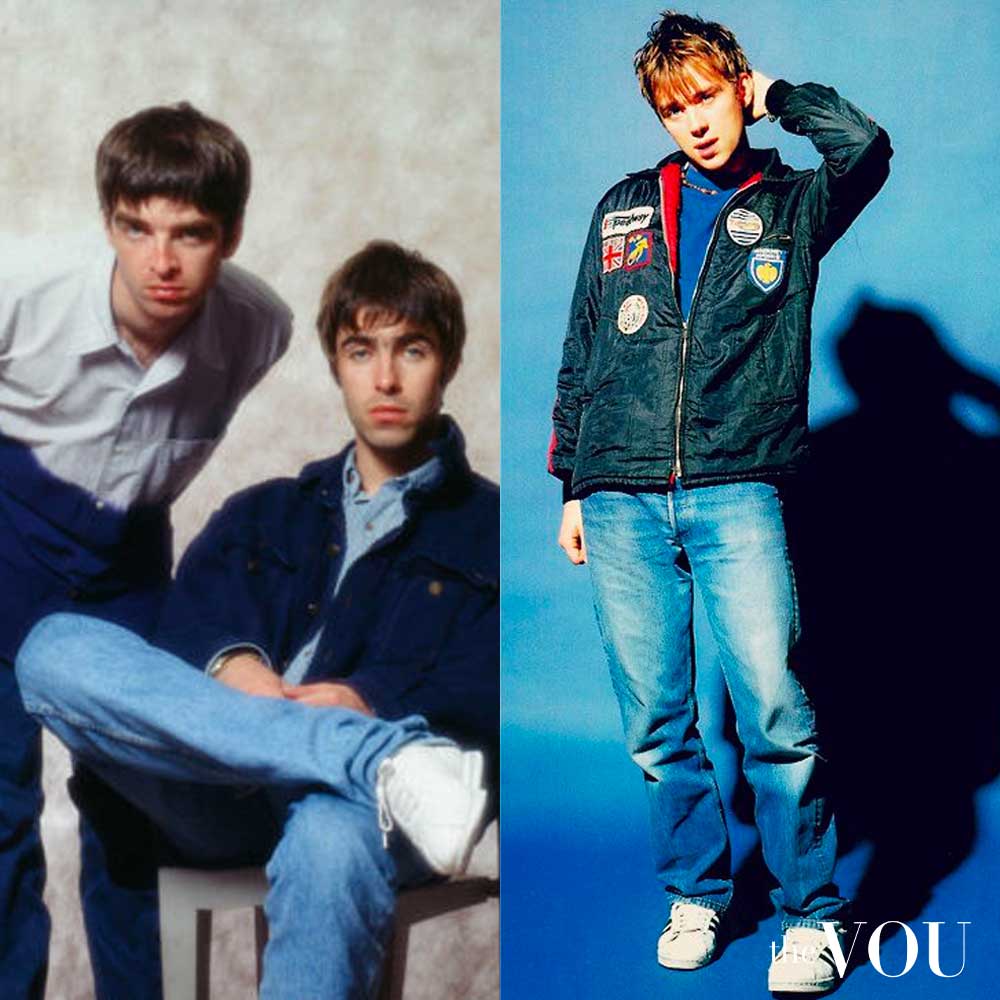
The Britpop style was a revival of Mod fashion of the 1960s but with a modern twist; comprised of tailored suits, relaxed fit jeans, button-up polo shirts, Harrington or denim jackets, parkas, loafers, and white sneakers, the style depicted a smart and refined look.
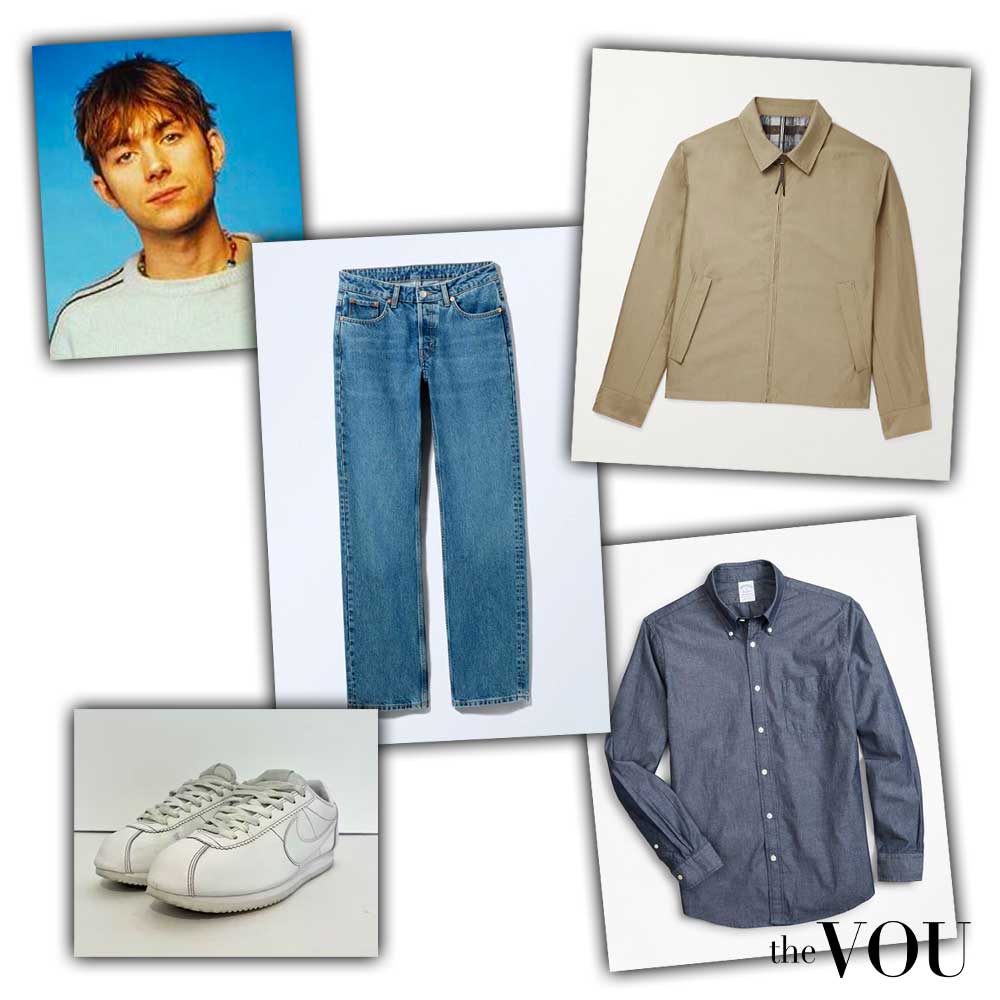
By intertwining classic British fashion with emerging Indie trends, the female icons of Britpop, like Sonya Madan of Echobelly and Louise Wener of Sleeper, with her tomboyish attire, captured Britpop’s laid-back yet polished essence.
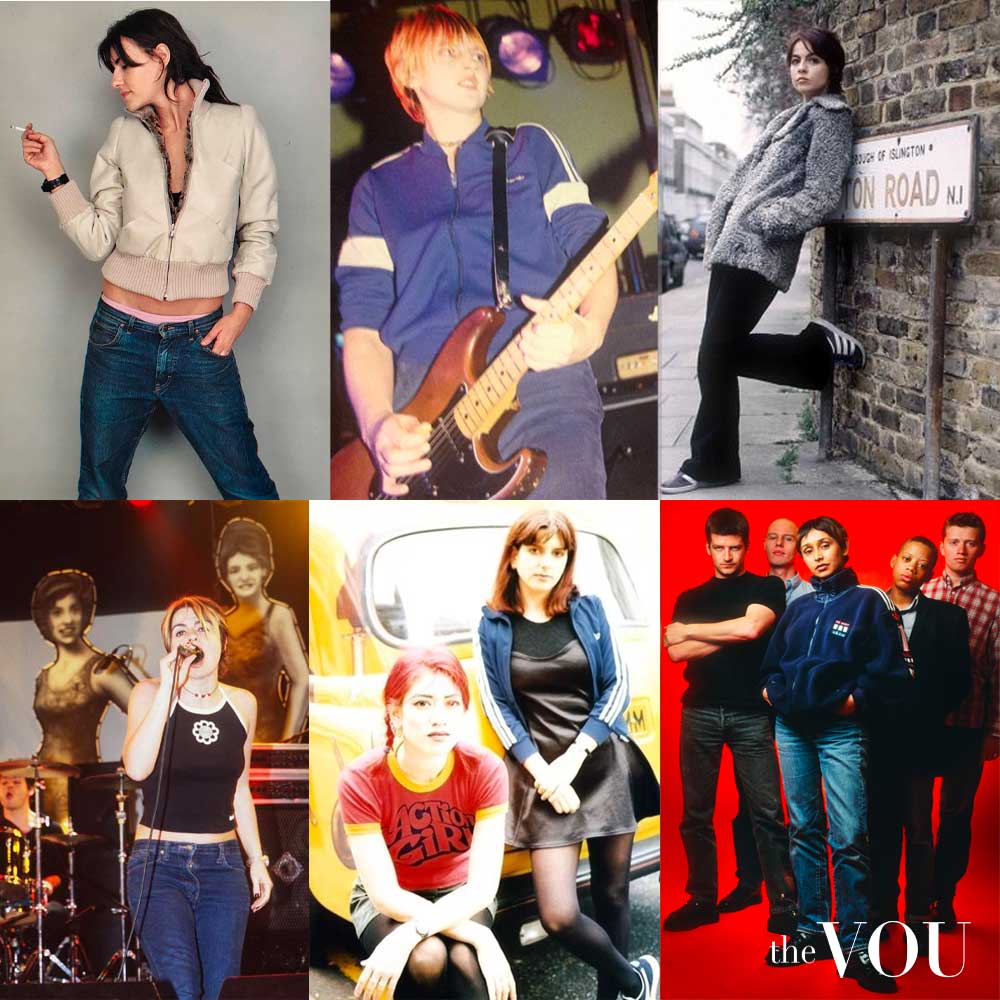
Miki Berenyi and Emma Anderson of Lush added a touch of feminine grunge to the movement while Justine Frischmann of Elastica made the combo of tank top, black tights, skirt, and iconic outfit.
Other notable Britpop figures are Jarvis Cocker’s (Pulp) with his corduroy and velvet blazers depicting a quirky and intellectual Britpop aesthetic, and Richard Ashcroft’s (The Verve) choice of iconic aviator sunglasses and trench coats highlighting the Bohemian infusion into the growing Britpop flair.

Beyond the music scene, the Grunge and Britpop movements had a significant role in the 1990s fashion as forms of expressing generational ethos while reshaping perceptions of beauty and style.
2000s to Present – Emo and Indie Rock
In the tapestry of 2000s fashion, Emo and Indie rock styles emerged as distinct yet interwoven threads, each narrating its own story through the language of apparel, accessories, and colors.
Emo
As the new millennium dawned, Emo fashion, with roots in hardcore and post-hardcore Punk, blossomed into a vivid expression of the youth’s emotional landscape.
The Emo aesthetic was popularized by bands like My Chemical Romance, Fall Out Boy, Panic! At The Disco, and Paramore.
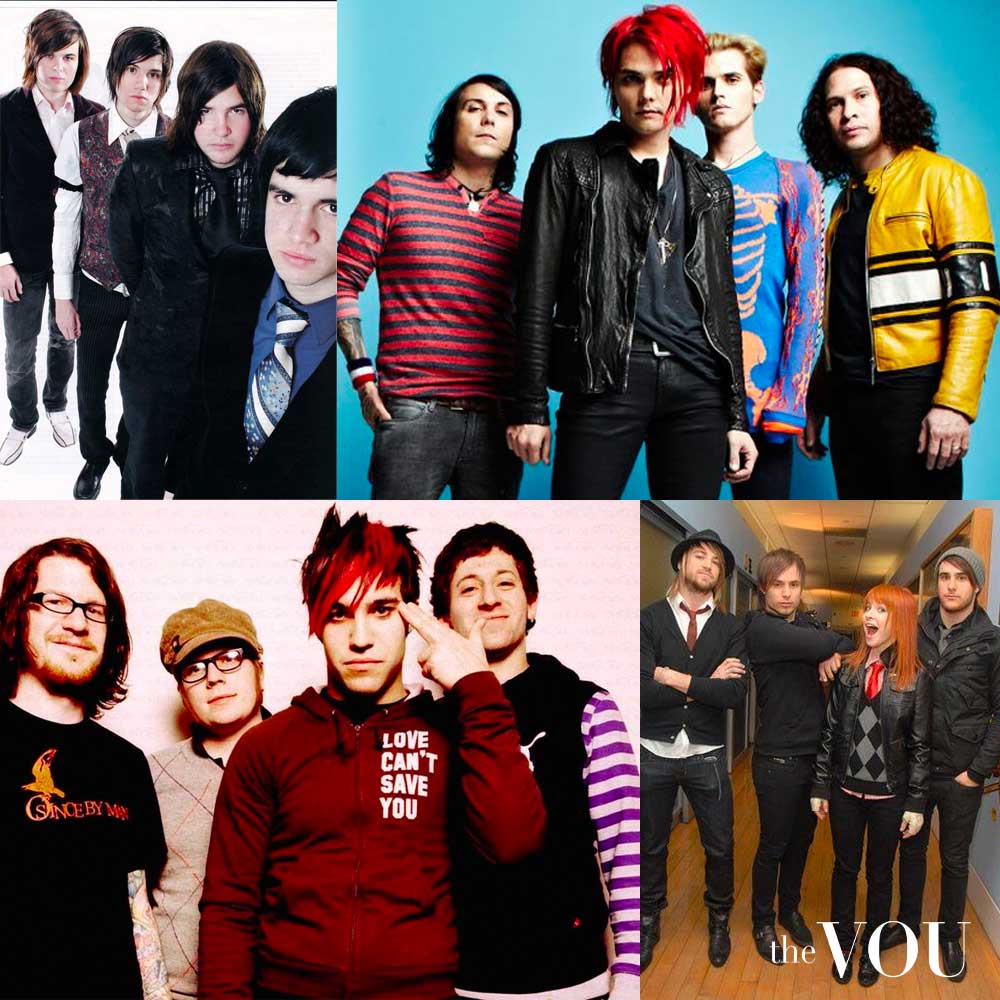
During the band’s “The Black Parade” phase, characterized by black, white, and red colors and Gerard Way’s black button-up shirt and red tie, My Chemical Romance became emblematic of Emo fashion.
Fall Out Boy’s bassist, Pete Wentz popularized the heavy eyeliner look, Patrick Stump the use of hats, and Paramore’s Hayley Williams became the signature orange hair.

Panic! At The Disco’s theatrical “A Fever You Can’t Sweat Out” era outfits, including Brendon Urie’s black top hat, skinny jeans, and long boots, were also defining.
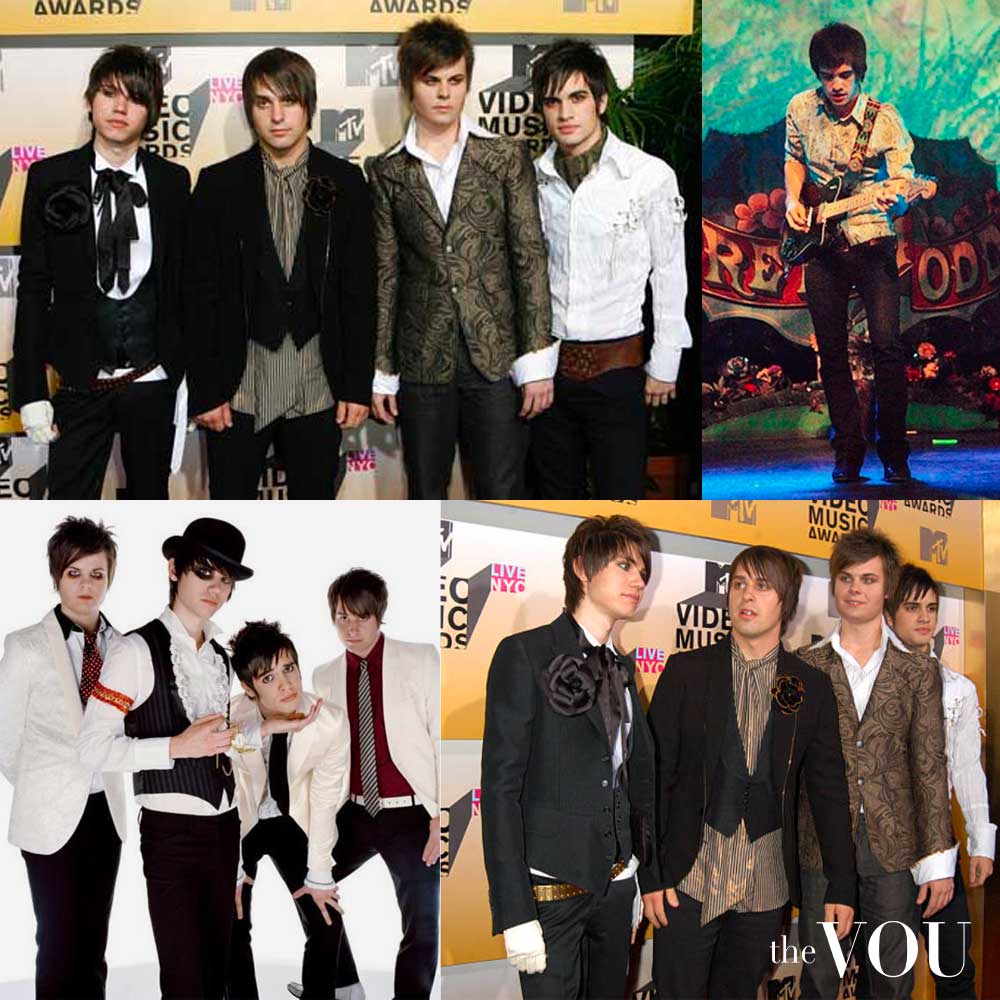
Adolescents wore black skinny jeans with studded belts – a nod to the Punk roots, stripped sweatshirts, and over short-sleeved t-shirts matched with black and red rep tie as badges of honor symbols of belonging and allegiance to the emo ethos.
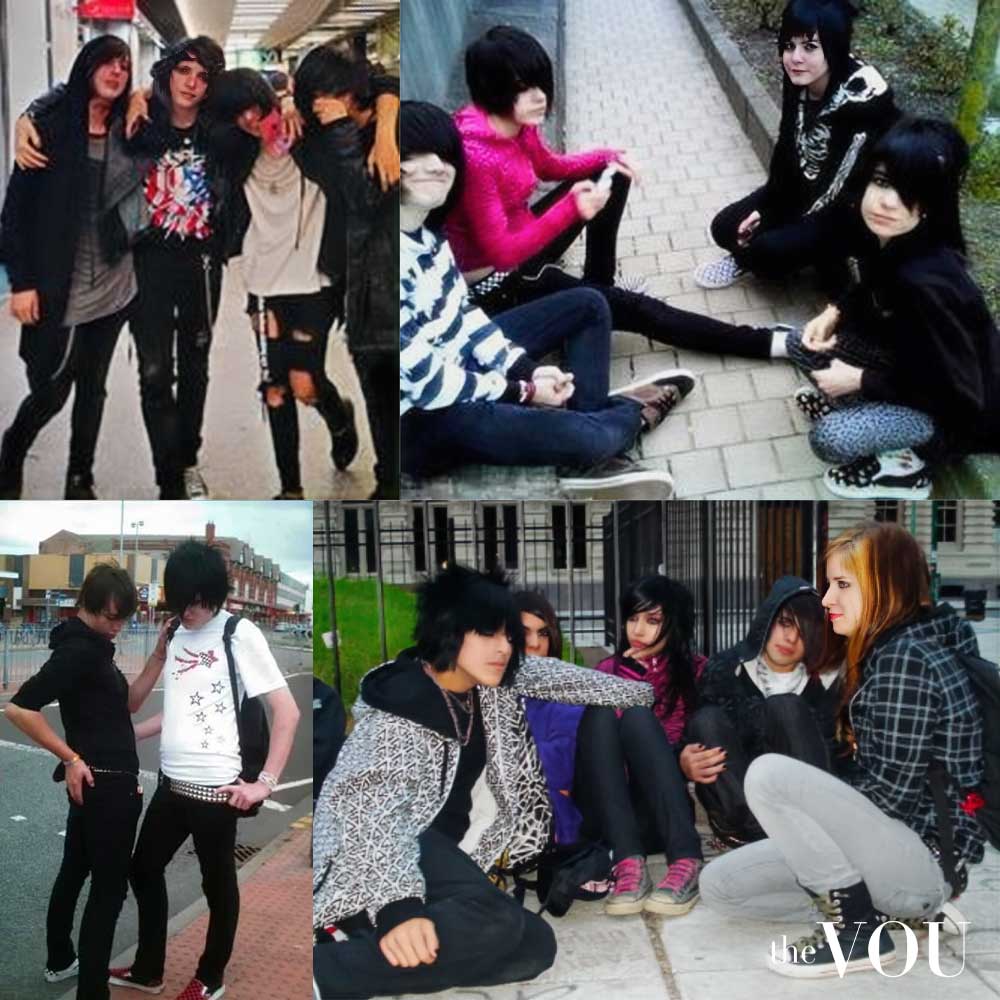
The Emo look was accessorized with metallic chains, rings, and earrings and completed with Converse and Vans sneakers and oversized black hoodies adorned with band prints and used to hide and comfort the misunderstood emo souls.
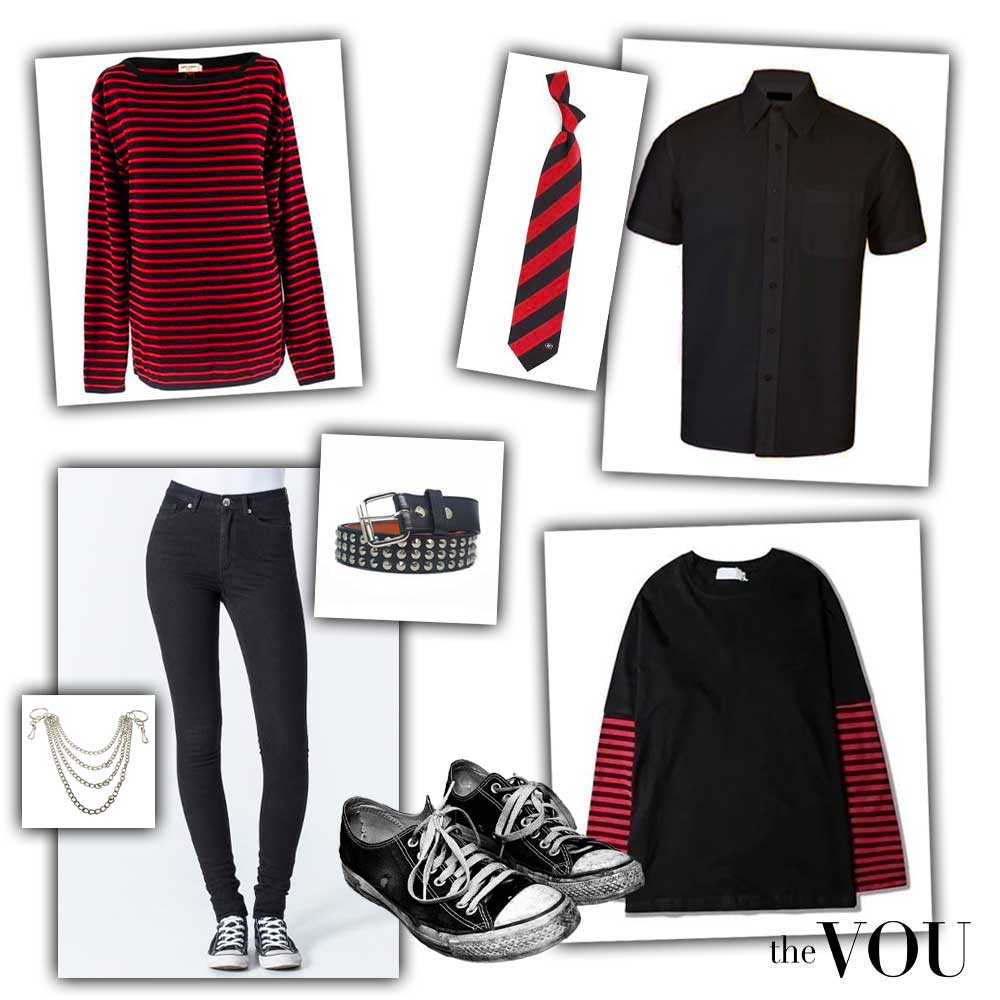
Indie Rock
In contrast, the Indie Rock fashion of the 2000s was a homage to the past, a resurrection of vintage garments combined into outfits that depicted a relaxed, artistic aura.
Indie fashion style, a distinct and eclectic look, was largely influenced by bands that championed the genre’s ethos of originality and independence.

In the 1980s, Indie pioneers like The Smiths set a precedent for the indie aesthetic with their blend of thrift clothes and collegiate wear.
By combining plaids, stripes, and floral print patterns with earthy colors and touches of pastels, the style reflects the movement’s artistic roots.
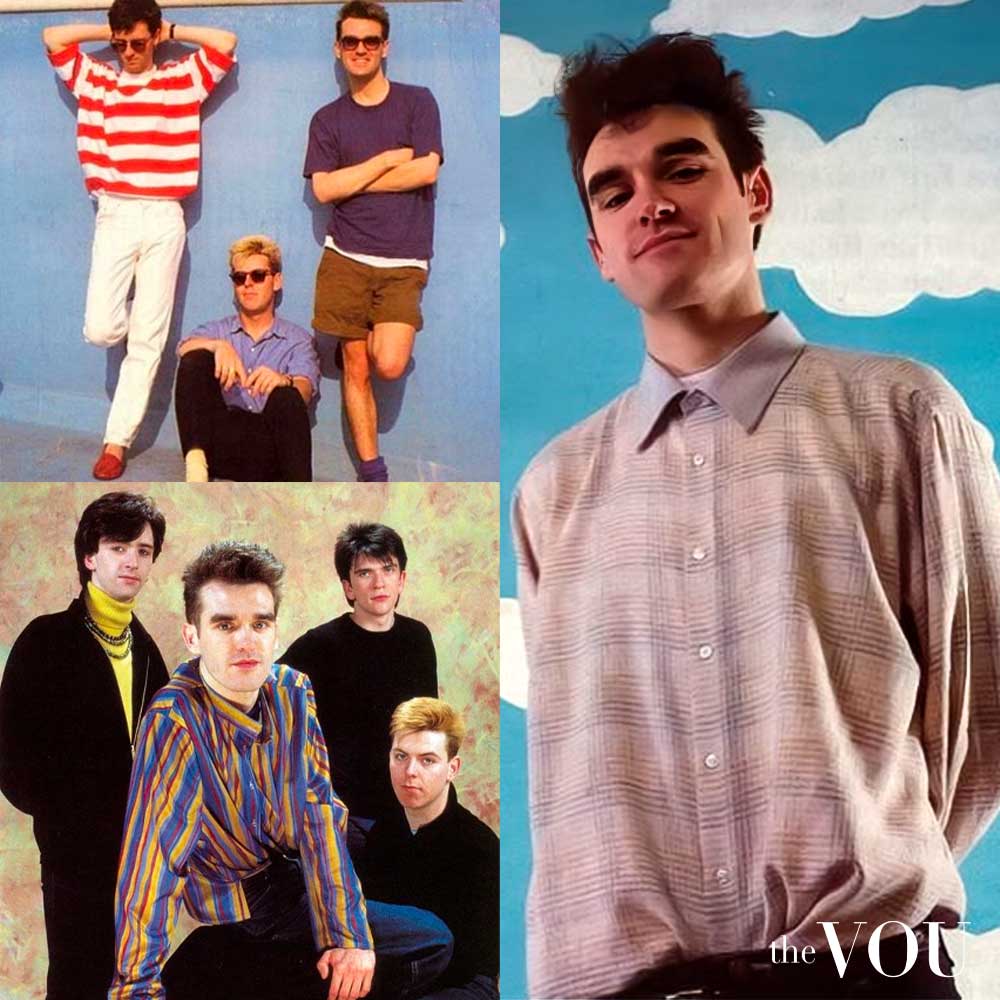
In the 1990s, bands like Pixies and Pavement continued the trend of understated, everyday garments synonymous with the indie look.
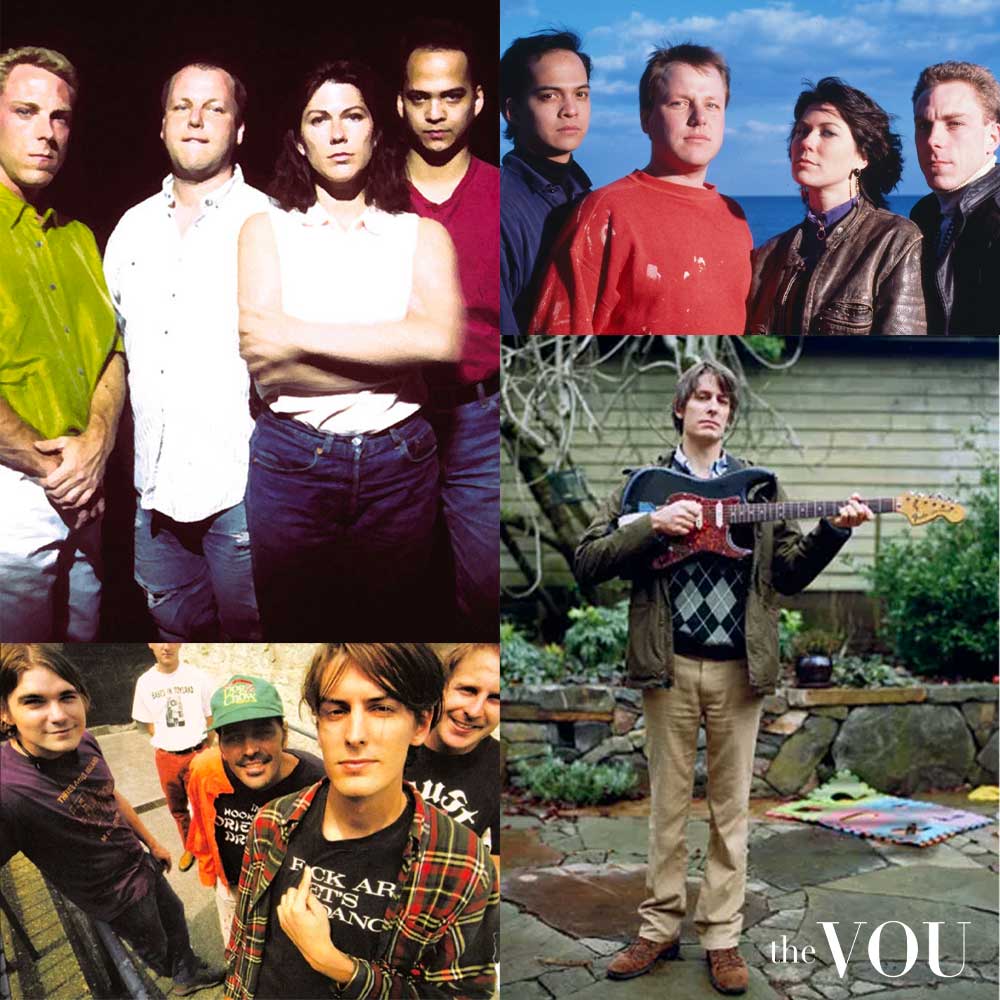
By the 2000s, bands such as The Strokes and Arctic Monkeys updated the style with slim-fitting jeans and leather jackets, blending vintage and modern garments for a modern Indie look.
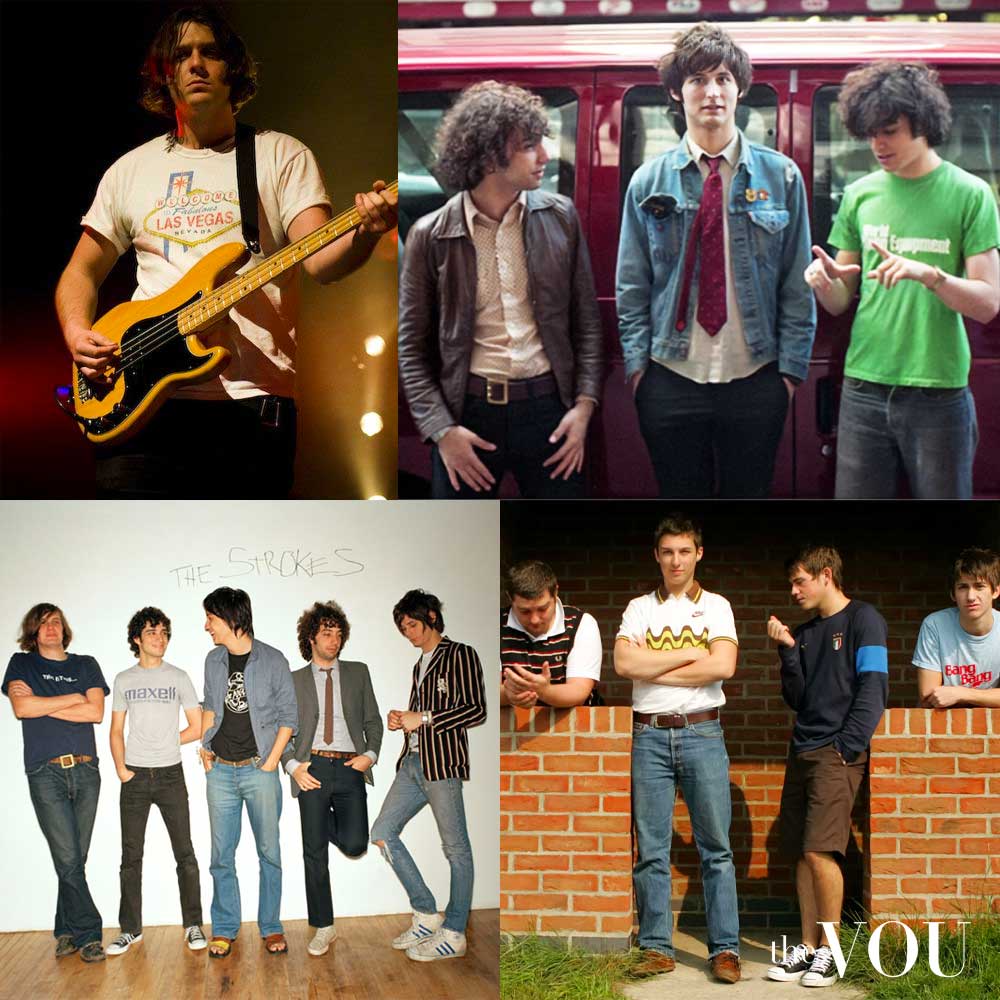
Influenced by the music scene of pop-punk, emo, indie-pop, hip-hop, deathcore, and rave, the mid-2000s Indie style comprised flannel shirts, retro T-shirts, jeans or corduroy pants, converse shoes, and leather accessories in a nod to the scholarly, intellectual vibe of the Indie subculture.
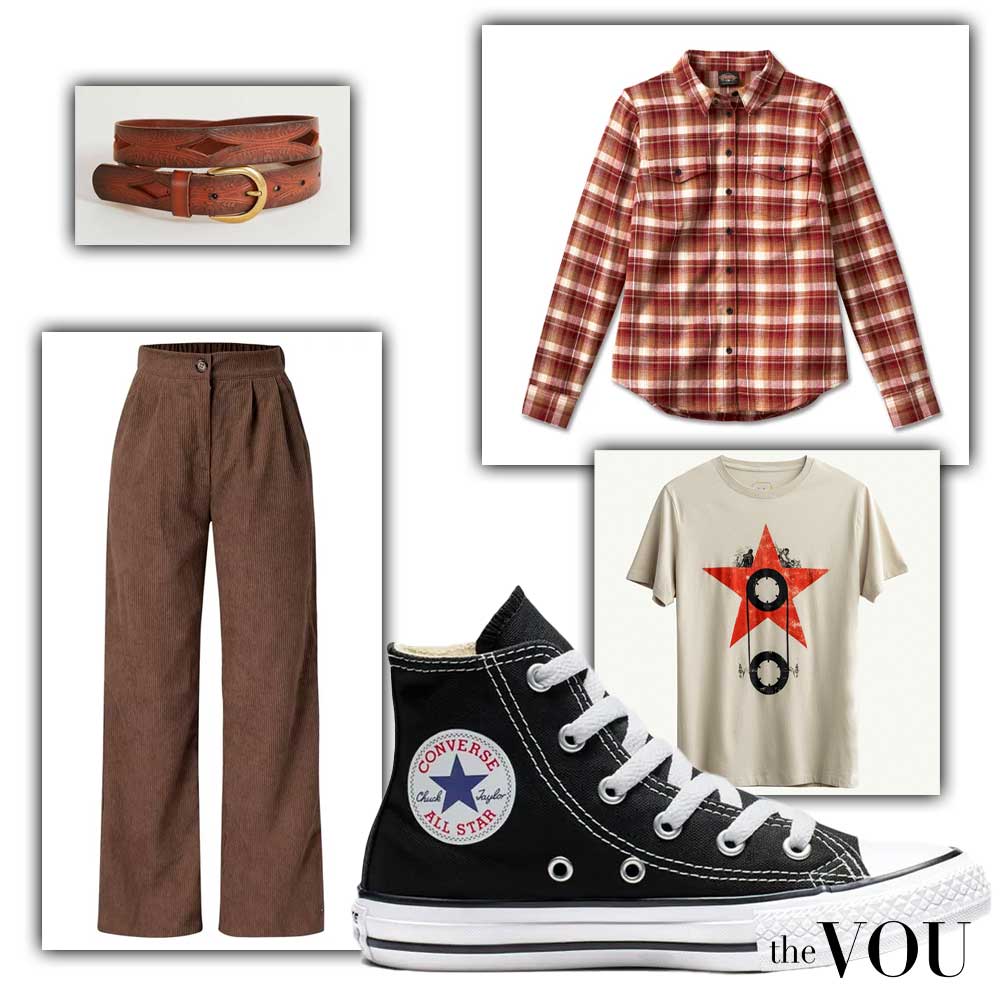
Twee Fashion
Defined by artists like Belle & Sebastian, Neutral Milk Hotel, and Zooey Deschanel, Indie-folk, a subset of Indie Rock, brought forth a whimsical, 60s-inspired “Twee” fashion.
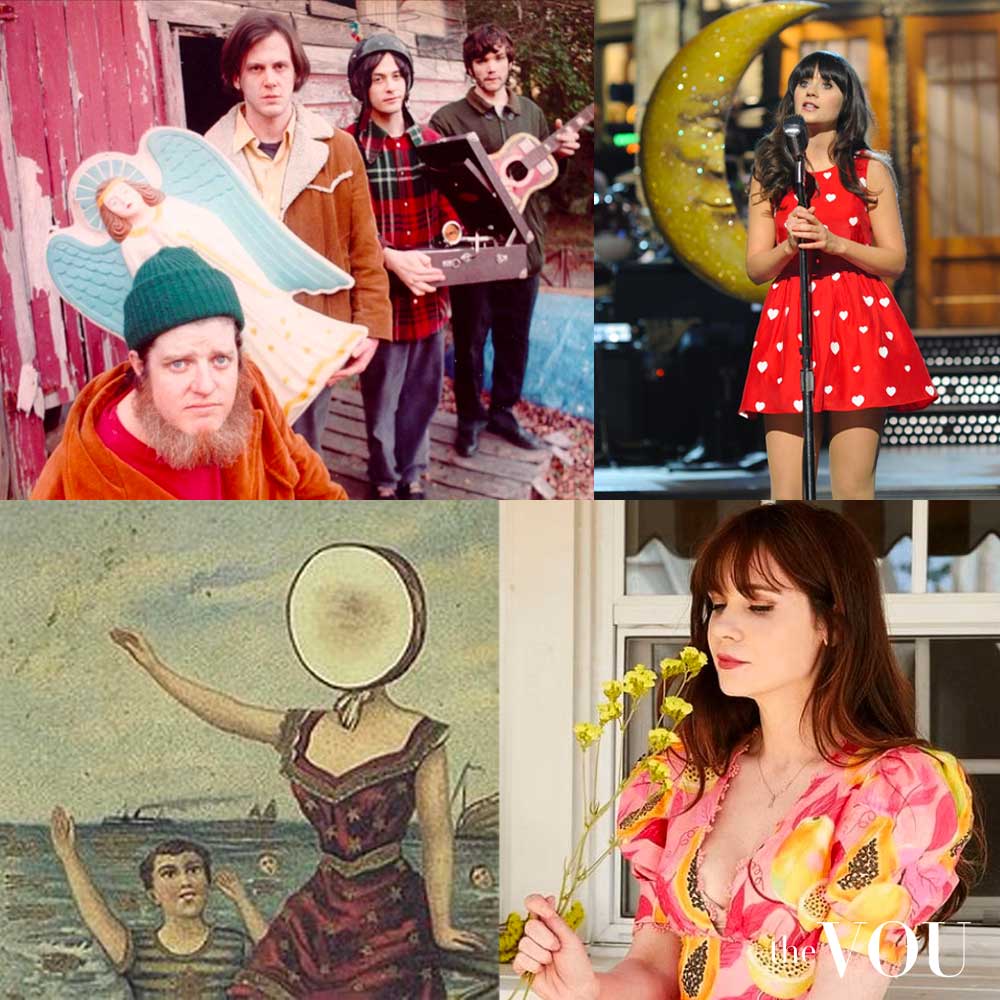
The Twee fashion style is characterized by box-pleated skirts, cutesy frocks, cardigans, overalls, knit hats, leather satchels, and vintage accessories.
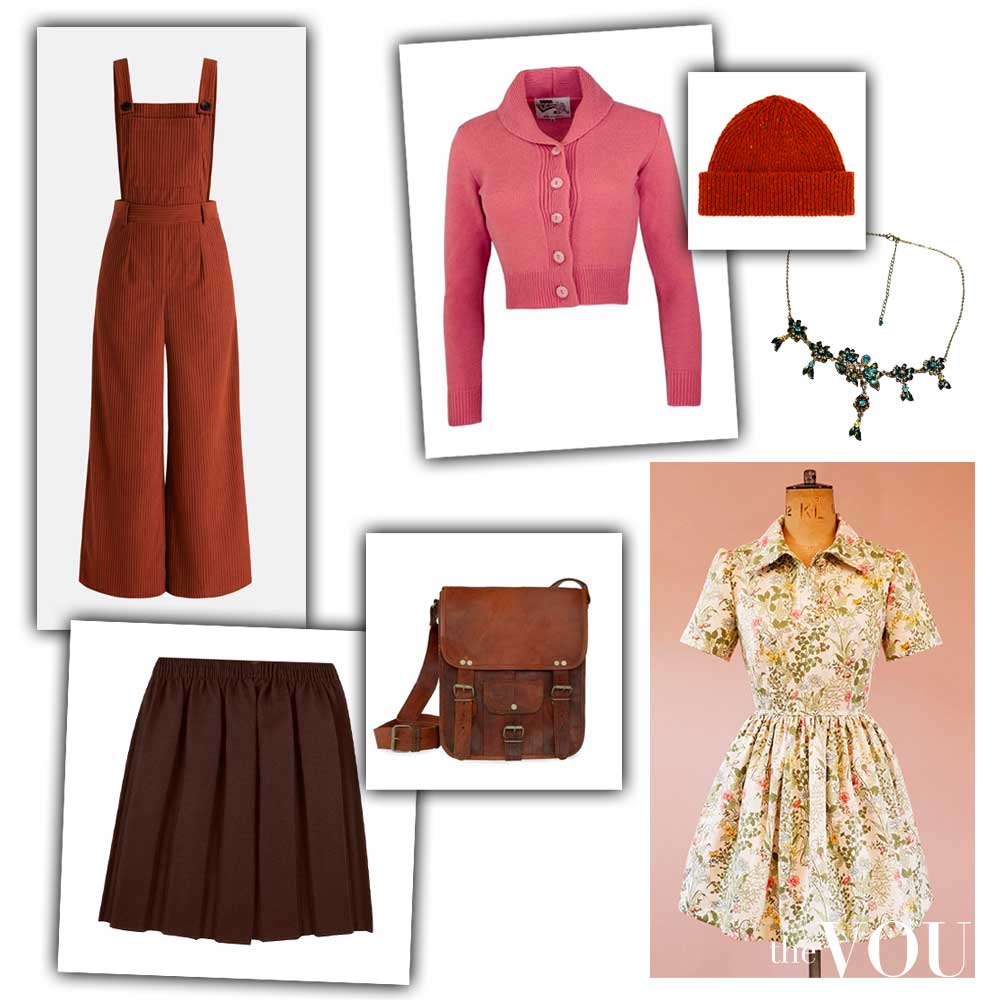
Weekly Newsletter
Keep up with the latest in fashion, beauty and style!
Rock Impact on Mainstream Fashion and Haute Couture
Rock’s rebellious and nonconformist attitude has impacted mainstream and high fashion through the decades and shaped significant trends.
Characterized by edgy fashion choices – at least for those times – icons like Elvis Presley and The Beatles symbolized the 1950s rock and roll music and attitude.
Anti-establishment Ethos
In the 1970s, punk rock’s anti-establishment ethos and provocative look further revolutionized fashion through designers like Vivienne Westwood and Malcolm McLaren, who brought the looks to the runway.
Contemporary designers like Rei Kawakubo, Martin Margiela, and Rick Owens have drawn inspiration from punk’s ethos of challenging norms and defying traditional aesthetic ideals.
Androgyny
With flamboyant and theatrical outfits, Glam rock artists like David Bowie redefined traditional tropes of masculinity and pushed the boundaries of gendered clothing.
Contemporary artists like Janelle Monáe and Lady Gaga have continued the tradition of glam rock’s theatricality and sensational dressing.
Fashion houses such as Jean-Paul Gaultier, Miu Miu, and Gucci have honored Glam Rock icons like David Bowie in their collections, showcasing the enduring appeal of this style.
Nowadays, the legacy of Rock fashion is evident in collections from designers such as Alexander McQueen and brands like Saint Laurent.
source https://thevou.com/fashion/rock-fashion-history/
Comments
Post a Comment